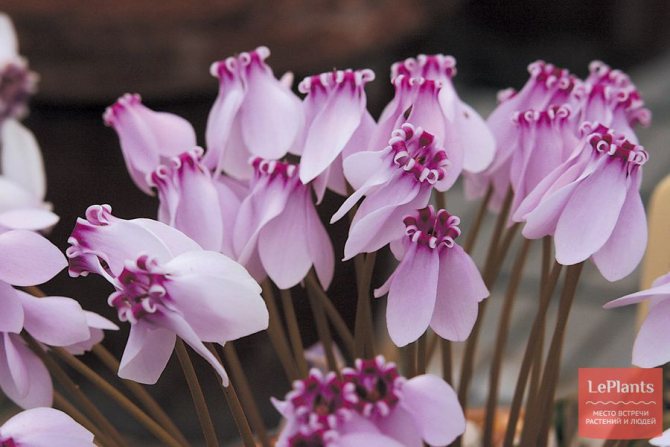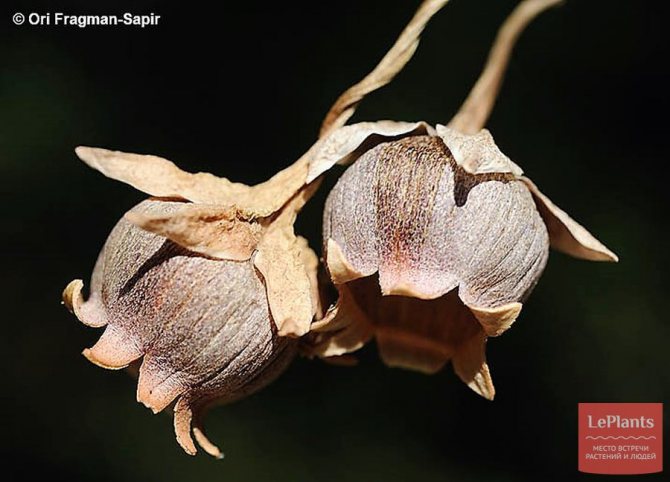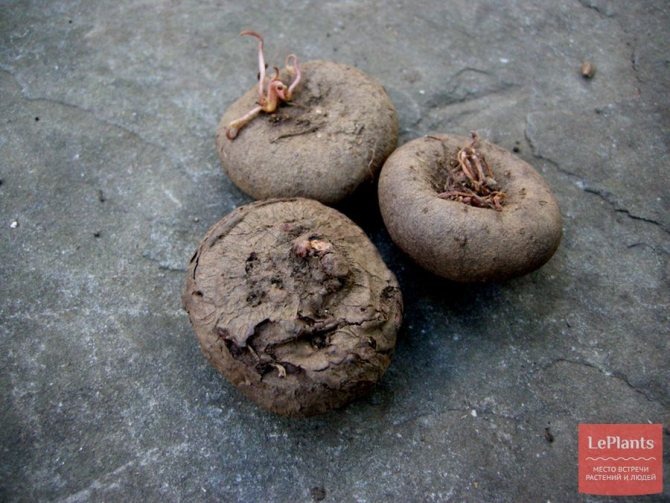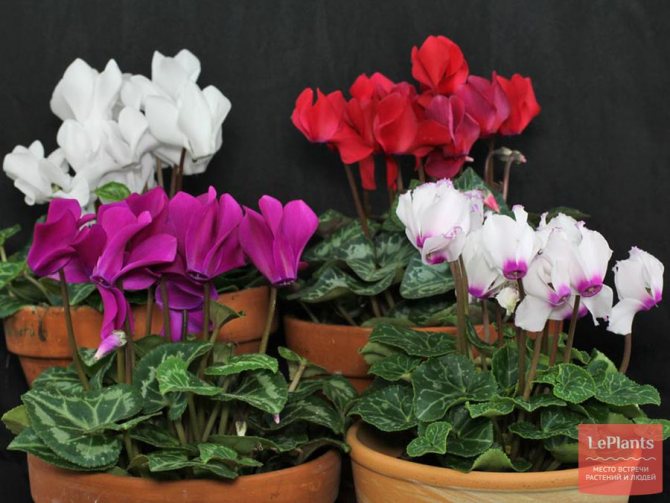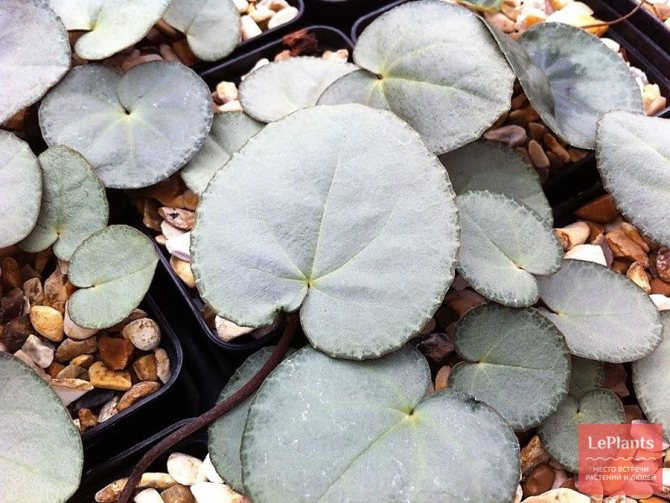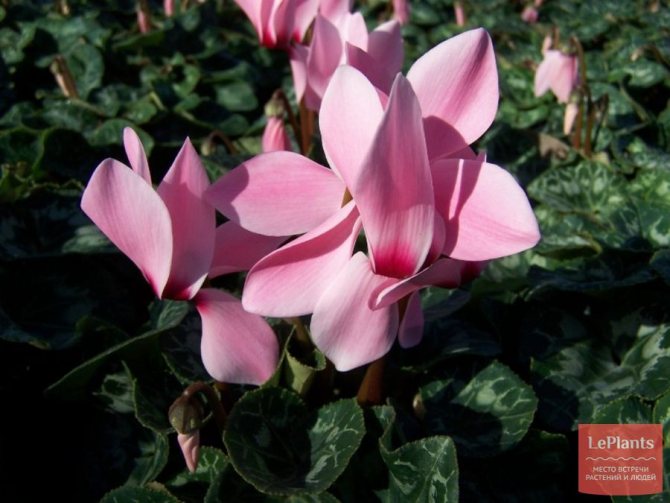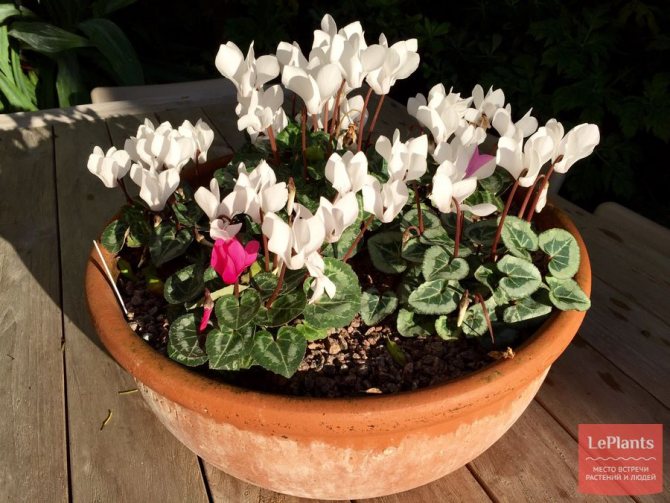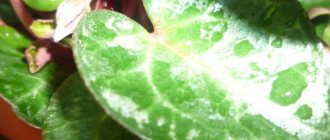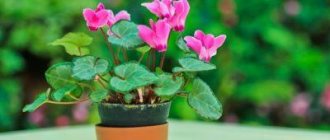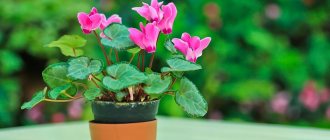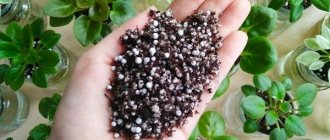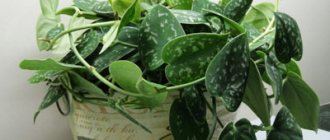On every flowerbed you can find at least one variety of violets... These flowers are so popular due to the variety of shapes and colors, as well as their unpretentiousness.
Most varieties belong to the wild, and only a few are bred by breeders. Forest varieties are very popular among flower lovers. Let's take a closer look at what a forest violet looks like - photos and names.
Alpine violet description
Its other common name is purple cyclamen (European), and in common parlance it is dryak. This flower can be found all along the Mediterranean coast and in the mountains of Northeast Africa. The plant loves coolness and does not tolerate heat at all. Therefore, its life cycle is divided into two periods: rest and growth. In the summer, the alpine violet sheds its leaves and "falls asleep", and in the fall it is time for the growing season. It blooms all winter - from October to March.
The buds of this plant have delicate oblong petals of white, purple and pink. The green leaves with silvery patterns are shaped like a heart.
Botanical reference
Cyclamen purple, summer alpine violet (Cyclamen purpurascens
syn.
C. europaeum, C. fatrense
) - an evergreen, sometimes deciduous tuberous perennial from Eastern Europe, a representative of the primrose family, 10 cm high and 8-10 cm wide. Leaves are round to heart-shaped, shiny, dark green, up to 8 cm long; sometimes slightly silvery-variegated; below purple-red. Flowers with curved edges, very fragrant, from pale carmine to red, up to 2 cm long; bloom in mid and late summer. By the end of flowering, after fertilization, the shoots twist tightly. When ripe, the seeds harden, being in a rounded box, which ripens in the summer only a year after flowering, opening in 5-10 parts. Knowing this, experienced flower growers remove the cyclamen bolls before ripening, put them in a vessel or paper bag, where the seeds will not scatter to the sides.
Alpine violet: home care
An unpretentious flower in natural conditions requires special attention for indoor breeding. Only with the right approach, the cyclamen will not die and will bloom for several months in a row.
| Description | Leaves | ||
| Cyclamen Persian | Perennial, up to 30 cm high, has a round fleshy root formation, 15 cm in diameter. Does not form daughter processes. | Large, up to 14 cm in diameter, growing from a tuber, heart-shaped, dark green with a light pattern, red-brown petioles. | They have five pointed, curved petals, up to 5 cm long. Rich colors: white, pink, burgundy, purple, dark red. |
| Cyclamen purple (European) | Low plant 10-20 cm in height. Small tubers are entwined with root shoots. | Small - 2-4 cm, rounded. The upper part of the leaf is green with silvery painting, the lower part is dark red. | They consist of five drooping petals of pink, rich crimson or purple. Cherry flower stalks. |
Dormant period
Description
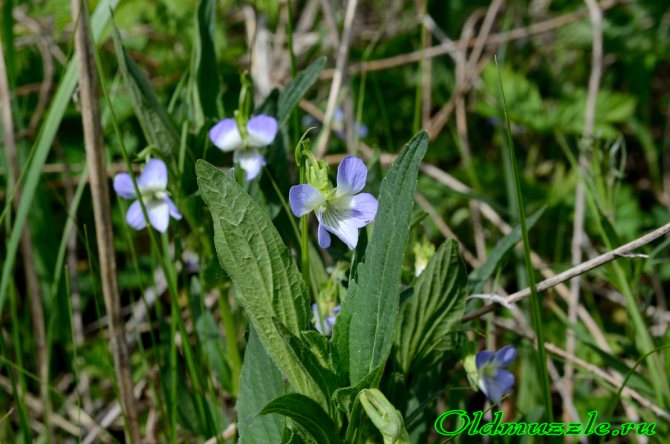
Like all "featherless bipeds," I also tend to be wrong. My haste is to blame for this, I overlooked one of the defining signs, as a result, in this article, two types of violets were mixed !. Now I figured it out (I hope) and urgently fix my flaws.Again, I hope my mistake didn't hurt anyone. I must say that I have not seen tall violets in the Arbekov forest. I only come across it on the right bank of the Sura.
Upd 2019. Found along the Valyaevskaya road. Arbekovsky forest is magnificent!
So, the violet is tall - a slender flower, with elongated ovoid leaves of a dark green color. At first glance, the flowers seem to be blue - a very strange effect, but after a while you realize that the flower is pale purple in color. This violet is not only slender, but also tall, it is not for nothing that it bears this name. In our area there are other violets, even many other violets, but I have only two so far (and one more on the way): an amazing violet (only with basal flowers and non-flowering stem flowers), and a field violet (with yellow-white flowers and with feathery stipules).
Flowers
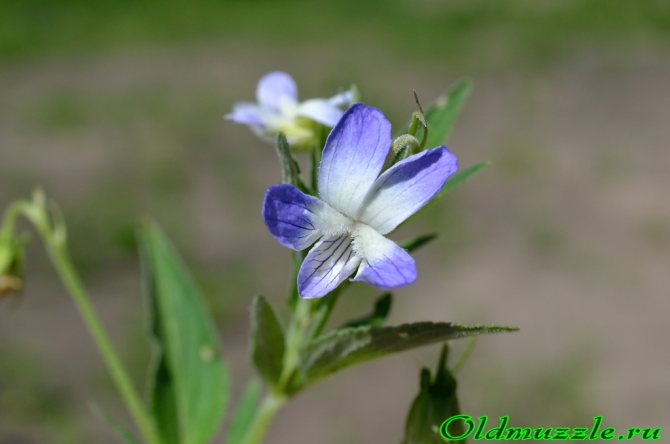

The corolla consists of 5 petals, the lower petal at the back turns into a spur with nectar. The petals are blue-violet, the pharynx is white with purple stripes. Blooms from May to July.
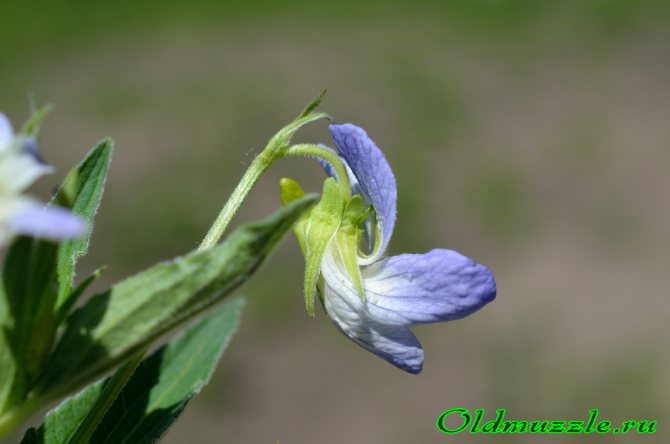

Side view: a spur and a green calyx, the structure of which I did not manage to understand ..
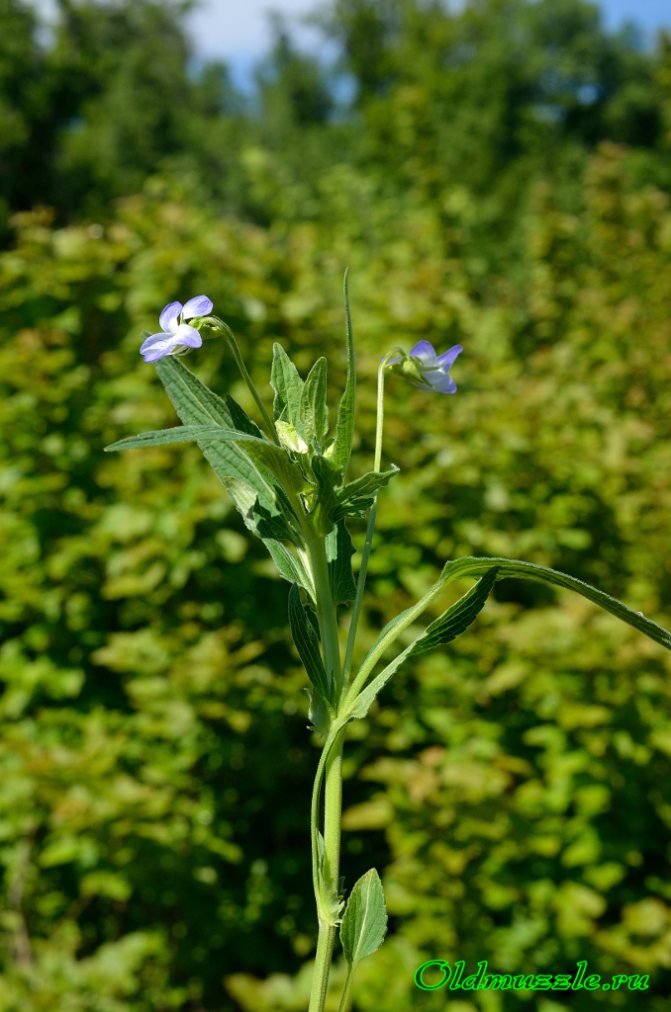

Hazmogamous flowers, that is, flowers pollinated in the open state (like most flowers), grow from the axils of the stem leaves, such flowers do not grow from the axils of the basal leaves.


Bracts grow in pairs in the upper third of the peduncle, in fact, near the flower.
Leaves


There are no basal and rosette leaves during flowering.


Stipules are whole, at medium leaves the stipules are longer than the petiole.
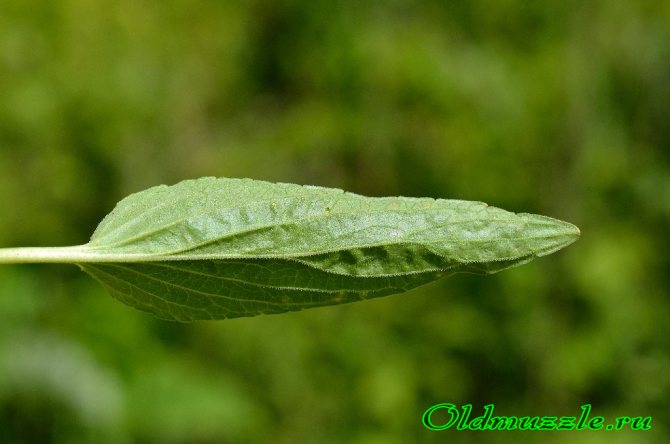

The middle leaves are narrow-ovate, unequally truncated at the base. The base of the leaf blade sharply (here again there was the word "suddenly"!) Narrows into a narrow petiole.
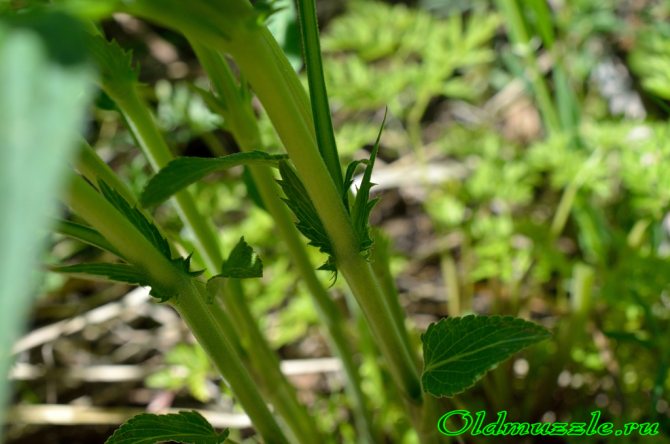

The lower leaves are on a long petiole.
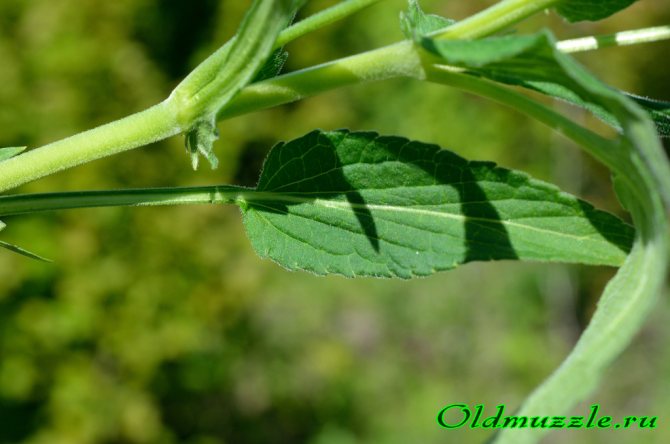

The stipules of the lower leaves are much smaller - one third of the length of the petiole or even less.
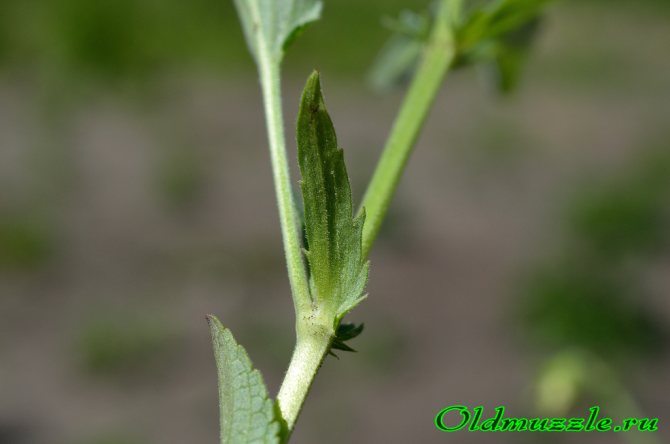

The middle leaf is about 6.5 cm long, and the stipule (to the right and below it) is 5 cm. The stipule can reach 8 cm in length. The stipules are coarsely toothed along the outer edge.
Despite my best efforts, I could not find the upper leaves with a heart-shaped base. Firstly, at the top there is a very dense bale of leaves and they are still underdeveloped, and secondly, they are still truncated there, but heart-shaped. Maybe you need to wait until the violets are still growing? We'll see…
Stem


Leafy stem, up to 50 cm high, erect. Stem leaves are alternate.
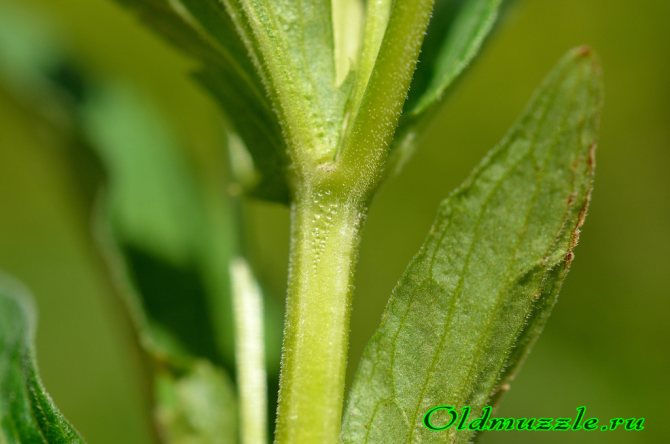

On the stem, just below the base of the stipule, droplets of liquid are visible. This is nectar. I wonder what purpose it serves? For flightless insects to also pollinate flowers? But the hairs on the stem are directed downward and make it difficult to move up. Maybe this "feeding trough" - a warning like "Food is here, no need to go further!"?
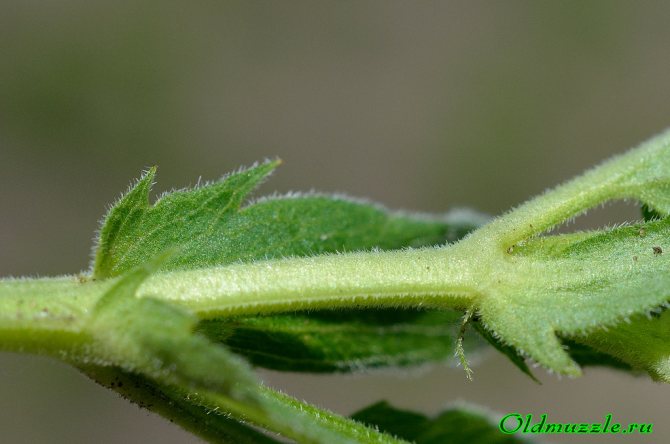

The stem is pubescent, and abundantly enough. The hairs on the stem are directed anise.
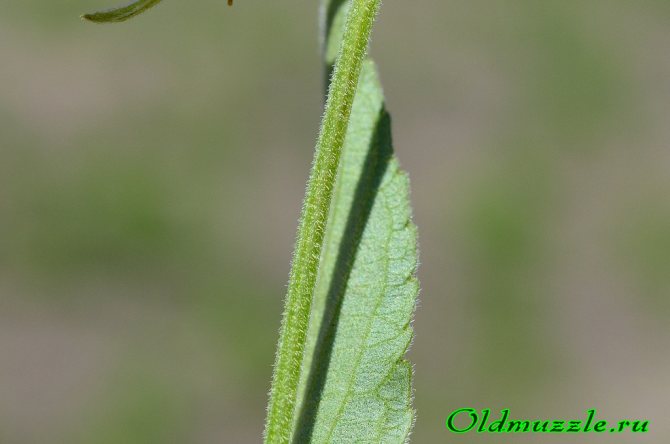

Pedicels are also well pubescent.


And even the stipules, and the leaves as well, are pubescent in full. If you come across a violet similar to this one, but lower and completely without pubescence, then this is a completely different species, but we will talk about it when the opportunity arises.
Fruit
Somehow I didn't get to the fruits.
Habitat
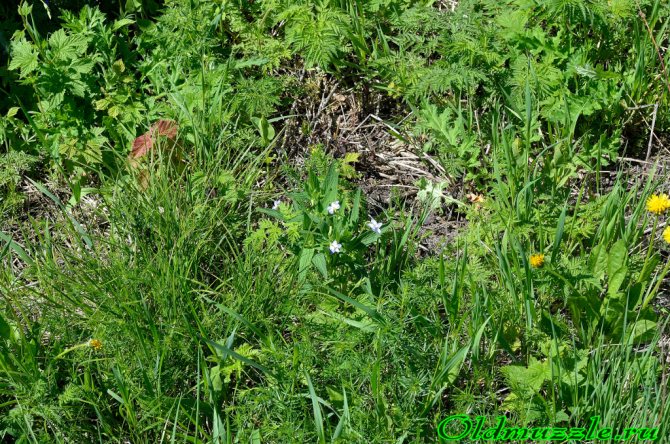

Violet grows tall in sparse forests, in clearings and forest edges, meadows. These photographs were taken on the glades of the right bank of the Sura.
Application
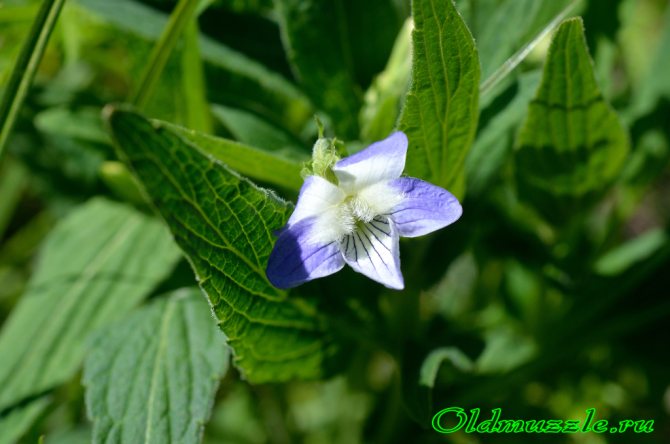

Almost little is known about the tall violet, but I think that it can become an adornment of any alpine slide.
Transplant and soil
Alpine violets are transplanted during hibernation closer to autumn, when the rudiments of leaves appear on the bulb with roots. The pot should be slightly larger than the root diameter of the tuber. Bloom does not occur in a large container.
A drainage layer is laid at the bottom, then the soil mixture is poured. For this, peat, sand, garden soil and humus are mixed in equal proportions.Dry or rotten roots are removed from the surface of the rhizome and immersed in the ground. The Persian cyclamen must be deepened by 2/3, and the European cyclamen can be completely covered with earth. If reproduction is planned, then before that, the onion is cut, leaving buds and roots in each part. The cut area is treated with coal.
To accelerate growth, the tubers are sprayed with special solutions and allowed to dry in the sun, but not in direct light. Then they are rooted in the ground. After transplanting, the pot is placed in a cool, bright place. Before the first leaves appear, watering should be scanty.
When propagating by seeds, it is necessary to put an earthen mixture in a shallow container, deepen each grain by 1 cm and level it. Cover the top with a light-impervious foil, regularly moisten the soil. After 30-50 days, seedlings will begin to appear.


Cyclamen Purple
Landing (transfer) rules
Choose a small pot for planting... The capacity should be 2-3 cm larger than the diameter of the tuber. The material has no special requirements, it can be ceramic or plastic. When planting, it is important to remember that the tuber is completely buried. The transplant is rarely performed - once every 3-4 years. The best time is the beginning of March. At the same time, daughter nodules are separated for reproduction.
Watch a video about the rules for transplanting (planting) cyclamen:
Site selection and lighting
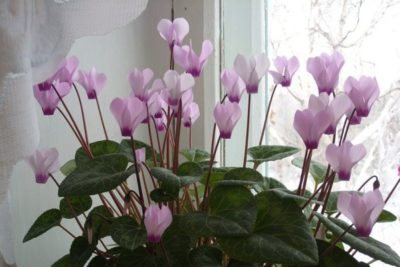

The European cyclamen requires careful selection of its location. The flower needs good, but diffused lighting. East and west windows are recommended. On the south side, high-quality shading will be required to avoid burns on the leaves.
Fresh air is vital for the alpine violet... She is sensitive to foreign odors; the pot should not be placed in the kitchen or smoked near it. At the end of spring, the flower is put on the balcony or in the garden, always in partial shade.
Soil requirements
The substrate should be loose and light. On heavy soils, purple cyclamen lags behind in development. The best option is to buy a special balanced mixture in the store. You can prepare the substrate for planting yourself, you will need:
- leafy land;
- peat;
- humus;
- coarse sand.
Advice: Recommended soil acidity 5.5-6.5 pH (slightly acidic or neutral).
Alpine violet: garden care
The ideal place for planting in the garden would be the crown of any tree or the foot of a shrub. This will protect the flower from excessive moisture during rain and direct sunlight. Cyclamen loves loose soil that allows water to pass through and does not retain. To do this, it is best to dig holes and fill them with a soil mixture of sod and leafy soil with the presence of rubble, which acts as a drainage. In a garden, the tubers are deepened by 10 cm to prevent freezing during the cold season.
During flowering, the alpine violet needs frequent watering. The ingress of moisture into the rosette of the leaves leads to decay of the plant. Dried buds and yellowed leaves are removed.
Before winter, the cyclamen is covered with a thick layer of foliage. Such a blanket will prevent the flower from freezing and retain moisture in the soil.
Miniature Cypriot cyclamen
One of the most compact types of cyclamen, Cypriot, grows to a height of no more than 16 cm. Despite its modest size, it has a persistent character: in nature, the flower is able to live and develop even on stony soils, it is not for nothing that its most numerous "settlements" are found in the mountains.
Perennial "baby" and blooms very gently, white or light pink inflorescences with a darker speck at the base. The flowering period of the Cypriot cyclamen falls at the beginning of autumn and sometimes lasts until the very end of winter.
Mr. Dachnik recommends: medicinal properties of alpine violets
The medicinal qualities of cyclamen have been used for several centuries. Its tubers contain substances that help fight polyps in the nose, sinusitis and sinusitis.Decoction baths relieve arthritis pain. Alcoholic tinctures from alpine violet bulbs are used for rheumatism, gout, intestinal disorders, and migraines.
Sprays with an extract from the plant rhizomes have an antiseptic and antimicrobial effect. In folk medicine, to remove pus from the sinuses in acute inflammation, fresh juice is prepared from crushed tubers and 1-2 drops are dripped into each nasal passage just once. This is enough for pus to begin to flow in half an hour. Failure to comply with the dosage can cause an allergic reaction and poisoning, because cyclamen is a poisonous plant. To avoid this, all medicines based on it are used on the recommendation of a specialist.
- alpine violet or cyclamen
- types of cyclamen
- alpine violet: home care
- alpine violet: garden care
- medicinal properties of cyclamen
- alpine violet: photo
- alpine violet buy
Threats and security measures
The rare violet is under the threat of complete extinction due to human economic activities: early haymaking, deforestation.
The rude attitude of man to the surrounding nature also has a negative meaning: numerous unauthorized dumps, trampling of grass, breaking off flowering plants.


One of the varieties of mountain violet
In order to protect the endangered species of the described violet, it is necessary to carry out comprehensive measures aimed at preventing a decrease in its number:
- search for new habitats;
- control of the existing population of the species;
- a complete prohibition or restriction of human economic activity in habitats (haymaking can be carried out after the seeds of the violets have ripened - in the second half of summer, felling should be of a selective nature and sanitary value);
- implementation of raising the culture of human behavior during his stay in nature.
Mountain violet is now rarely cultivated, but in order to preserve the species, it is possible to develop programs for its cultural reproduction.
Expert opinion
Yulia Yurievna
I have a large garden and vegetable garden, several greenhouses. I love modern methods of plant cultivation and soil mulching, I share my experience.
Ask a Question
Types of cyclamen
The most common types of cyclamen:
Cyclamen Persian
- herbaceous plant. It has spherical compacted tubers up to 15 cm in diameter, from the lower surface of which roots extend.
Leaves
heart-shaped, up to 14 cm in diameter, green below, above with a gray-silver pattern.
Flowers
with oblong-lanceolate petals 5 cm long.Slightly curled petals are pink, white or lavender
coloration
with purple spots at the base. The flowers have a pleasant
aroma.
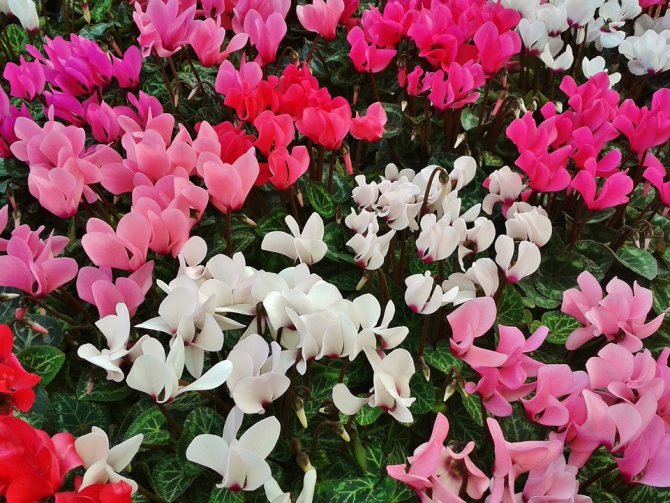

Cyclamen european
- an evergreen tuberous herb. Tubers up to 10 cm in diameter, spherical or irregular in shape, along the entire surface of which roots are located.
Leaves
leathery, cordate-rounded, dark green with a silvery pattern, dark red underneath, 2-4 cm in diameter.
Flowers
medium in size, about 2 cm long, pink in color and pleasant aroma.
Long flowering
from spring to autumn.
To date, many varieties have been bred, with large and miniature flowers of various colors, from bright red to almost black.
Cyclamen European:
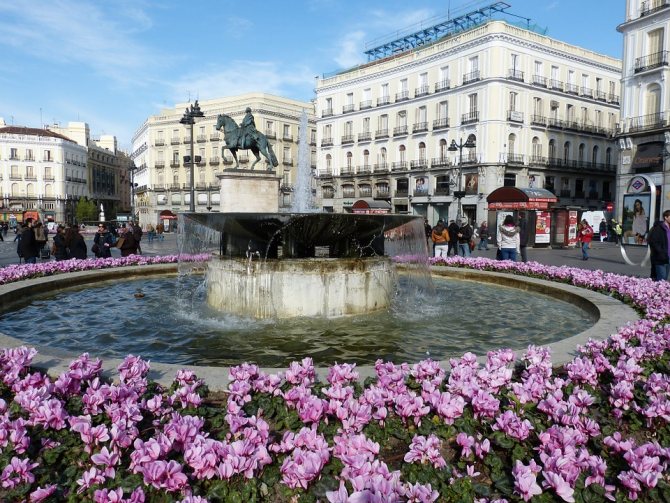

Flowering time
Persian cyclamen blooms in the autumn-winter period, which is its clear advantage. Flowering begins in the second half of October and continues until the end of March. Cyclamen pleases us with its flowering for about 3.5 months !!! Flowering times may vary depending on the variety and conditions of detention. Persian Cyclamen can be seen on sale most often in winter, during the flowering period.
Cyclamen European blooms in spring and summer, almost until winter. Flowering begins in late spring.That is why Cyclamen European is most often bought in stores in spring or summer, in bloom.
The flowers of the European cyclamen are smaller than those of its Persian relative. But the shades of color are about the same: pink, white, dark red, purple in both species.
Alpine violet: home care
You will definitely be able to grow a beautiful flower that will delight you with long flowering. We will help you take care of
behind an alpine violet.
Where to keep and how to care for cyclamen?
Pots
with plants, keep on the east and west windows. Cyclamen pots in the room
place
in the coolest place, such as between window frames. But it is impossible to allow direct sunlight to hit the plant.
In winter
keep plants in the brightest place, with a temperature of 12-14 ° C. In warm room conditions, cyclamen for a long time
will not live.
During the flowering of the plant water
evenly, so as not to allow either drying out or waterlogging. When watering, try not to wet the tubers. When the plant is dormant,
cut watering
, water only so that the clod of earth does not dry out. Water sparsely and in moderation while tubers are rooting. Water through a saucer, abundantly in summer and moderately in winter.
Temperature
water for irrigation should be 3-4 ° C below room temperature. 1-2 hours after watering
excess water
pour out from under the clover to prevent root rot. Before the buds appear, spray the plants from time to time, as soon as the buds appear, stop spraying.
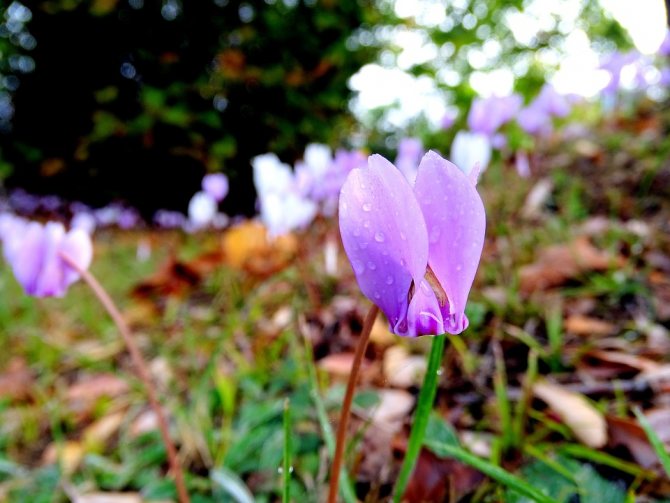

Some types, for example, cyclamen european
does not have a pronounced rest period. Have
Persian cyclamen
the dormant period is celebrated in the summer. At the beginning of summer, the leaves turn yellow and die off, only the tubers remain. From this period
water cyclamen
rarely.
For summer
pots with tubers can be taken out to the loggia or a balcony protected from the sun and rain.
Early autumn
bring the tubers indoors and transplant them.
For transplant
use a loose soil mixture consisting of turf, humus and leafy soil and sand in a ratio of 2: 1: 1: 1.
Soil acidity
pH 5.5-6.
Tuber
peel off damaged roots and plant, deepening 1/2 or 1/3. Place a drainage layer on the bottom of the pot. Place the tubers in a bright, cool place. Water occasionally until the plant takes root. When the first shoots appear, watering more often.
When and how to feed cyclamen?
As soon as the leaves grow before flowering, the plant feed
full mineral fertilizer (1g / l) every two weeks.
We do not recommend
use a lot of nitrogenous fertilizers, as the roots can rot.
How to propagate cyclamen?
In a greenhouse cyclamen propagated by seeds
... Seedlings grown from seeds bloom 13-14 months after sowing. Amateur flower growers can propagate cyclamen
dividing the tuber
... But this is not always possible. Therefore, it is advisable to purchase tubers in the fall in flower shops.
Why do cyclamens get sick?
- The flowers are strong and healthy, and the leaves turn yellow. What is the reason?
Indoor air is too warm and dry. Cyclamens cannot stand temperatures above 17 ° C. Perhaps the reason
yellowing of leaves
in insufficient watering or sunlight on the leaves. - Peduncles and leaf stalks become soft and rot
... The reason is waterlogging of the soil, especially if watering is carried out from above. Try to keep water away from leaves and tubers.
Water
through the pallet. - Flowers quickly faded
... The reason is high temperature, dry air, improper watering. - The leaves are deformed and curled. The reason - a pest appeared on the plants - cyclamen tick.
The most frost-resistant ivy cyclamen
One of the most common types of cyclamen, which is grown in the vastness of our homeland, including in indoor floriculture.
The characteristic features of the plant include:
- pink color of the petals (not counting the white-flowered hybrids, which do not occur in natural conditions);
- superficial root system;
- winter-spring flowering period;
- delicate aroma;
- small horns at the inflorescences;
- the rounded shape of the leaves with grooves, due to which they resemble ivy foliage.
Ivy cyclamen (or Neapolitan) can bloom both before the leaves appear, and simultaneously with their blooming.
It is possible to list the varieties of this diverse plant for a very long time, and even its hybrids cannot be remembered at all. Sometimes it is simply unrealistic to distinguish them from each other, and is it really necessary? They are all very beautiful, regardless of when the delicate flower butterflies bloom and what color they are painted. Let's just grow these amazing types of cyclamens on our plot or in pots and admire their beauty, because sometimes we lack a sense of unity with nature.
Cyclamen bloom - video
How to grow European cyclamen at home
The European cyclamen is also called the alpine violet or the crown of King Solomon. Indeed, its inflorescence looks like a beautiful crown shining on a graceful stem. This plant is capricious, requires care and careful care.
Alpine violet: garden care
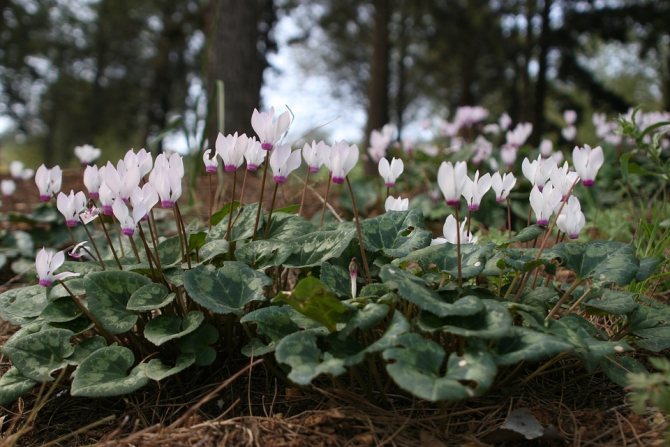

In our climatic zone best to grow
cyclamens in pots, but you can try growing this gorgeous flower outdoors. It is important to choose a reliable and good
landing place
... Cyclamen is afraid of rain, extreme cold, wind. The best thing
to plant
it under the crown of a tree to protect it from excess moisture during a rainstorm. When planting, you need to bury the roots well,
optimal depth
- up to 10 centimeters. Otherwise, your plant will freeze. An exception is if you live in a very warm climatic zone.
The soil
must allow air to pass through.
Watered
very carefully, in moderation, always keep an eye on the ground. Water at the root to keep the water out of the leaves. Required
cover up
your alpine violet for the winter, because the plant is afraid of frost. A thick layer of fallen leaves will do.
Cyclamen
- it is a delicate plant, but with proper care it can grow quietly in the garden for several years. Gardeners love it not only for its beautiful flowers, but also for its decorative leaves.
Freedom-loving alpine cyclamen
One of the wild-growing plant species is the Alpine cyclamen. For a long time it was considered extinct, but even today the flower can still be found, most often in natural conditions. The variety is characterized by the arrangement of the inflorescence petals at right angles (upright), in addition, they twist a little.
Alpine cyclamen blooms in spring, exuding a delicate honey smell, the main color of flowers is various shades of pink. The leaf plate is oval and slightly gray.
The healing properties of cyclamen
Many centuries ago, cyclamen was used in medicine
... Today this plant is popular with herbalists, healers, and also in medicine. On its basis, medicinal preparations are produced.
Attention!
Cyclamen is considered a poisonous plant, you need to use it very carefully for treatment, but it is best to purchase sprays based on it in a pharmacy! For medicinal purposes use
cyclamen juice
, it is obtained from tubers. It is an excellent antiseptic as well as antiviral. Modern pharmacology uses cyclamen juice to treat frontal sinusitis, sinusitis, sinusitis. it is found in many sprays.
According to an old legend, it was in the shape of a cyclamen flower that King Solomon decided to make his crown. Cyclamen liked the king for his discreet beauty and became a reminder for him that modesty is the quality of a truly wise ruler.The cyclamen flower really resembles a crown - delicate petals grow on a long graceful peduncle. Not surprisingly, this charming, touching plant has won the sympathy of professional gardeners and amateur gardeners.
Very often, different types of cyclamen (and there are about twenty in total) are also called "alpine violet". This is not entirely correct, since the alpine violet is only a European cyclamen or a blushing (purple) cyclamen. In the wild, as the name suggests, it is found in the Alps. But in room culture, this type of cyclamen is very rare. Only the most experienced growers will tell you where you can buy tubers and seeds of European cyclamen.
Cyclamen European is often confused with the so-called Persian cyclamen - a larger plant with a relatively early flowering period. Meanwhile, the "European" has characteristic features inherent only to him. First, it is the only non-deciduous type of cyclamen. When the dormant period comes, it stops growing, but does not shed its leaves. Secondly, the European cyclamen has smaller leaves and flowers. Leaves are rounded, slightly elongated to the tip. The edges of the leaves are smooth. Thirdly, the flowers of the European cyclamen are usually bright pink. There are also very rare, so-called "alba-forms" - just white flowers or white with a crimson eye.
Finally, the flowers of the European cyclamen smell very nice; as the owners of the “Europeans” themselves write, the aroma varies from “simply pleasant” to “the aroma of expensive perfume” and even “divine”. The intensity of the scent depends on the intensity of the color of the flower itself: the lighter the flower, the subtler the scent. It is interesting that on the day of opening, the flowers may not smell at all, and their petals are initially very thin and pale. Over time, the aroma intensifies, and the petals gain color, straighten and thicken.
It was already mentioned above that as an indoor flower "European" is now quite rare. So you're in luck if you have a truly real alpine violet living on your windowsill!
Forest violet: description and photo
Like most other flowers, the genus of violets counts many copies, among which there are many forest dwellers.
Some varieties that do not grow in the forest are also classified as forest violets.
Name forest violet belongs to a tricolor variety... This variety became the basis for sectioning a pet in flower beds - "Pansy".
Below you will see pictures of forest violets.
Attention! Other species that are classified as forest are simply similar to this or have a similar habitat.
Varieties of varieties
There are a lot of forest violets on the list. It is worth highlighting those that are especially popular with flower growers. Among them:
- Forest tricolor;
- Doggy;
- Swamp;
- Fragrant;
- Altai;
- Aetolian;
- Stop;
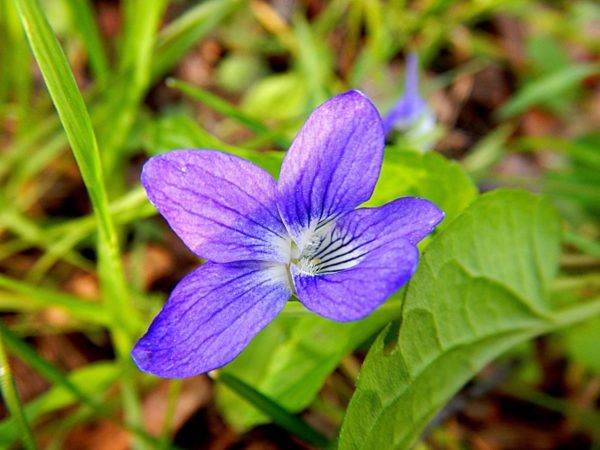

In the forests, you can find various beautiful violets. - Incised;
- Hairy;
- Reifenbach;
- Rivinius;
- Palm-shaped and others.
Most violet flowers difficult to find in nature, and they only remain in the flower beds. Many species are already listed in the red books, both territorial and international. There are also varieties that until recently could be found, but now they are considered extinct. But at the same time, the forest violet grows wild.
Distribution area
Violet spread halo very big... There are varieties in America, most grow on the Eurasian continent, but the least number of species grows in Africa and Australia.
Forest varieties mostly grow in Europe, there are several varieties from America and Asia.
The main part prefers wooded, swampy and mountainous areas, depending on the species. Photo of flowers is presented on the left.
Description
Like all beautiful flowers, violets have their own history, or rather two legendswhich the Greeks appropriated to them.
According to the first legend the violet was created by Zeus.A gentle nymph, fleeing from Apollo, asked for protection from the supreme god. Protecting the girl from the rays and heat of the sun, Zeus turned her into a beautiful flower and hid her in the shade, under a bush.
There she grew and pleased only his eyes, but one day Persephone stumbled upon a beautiful plant. She collected a beautiful bouquet, and returning home was stolen by Hades, and the bouquet crumbled... So beautiful flowers scattered over the earth and began to grow in the shade, delighting all people.
The second legend says about involvement in the appearance of flowers of the goddess of love and beauty Aphrodite. The beautiful one wanted to swim and noticed the men who were spying on her.
Angry, the goddess called on Zeus to condemn the guilty, demanded to kill them. But the supreme god took pity on the mortals and released them, but turned them into punishment in flowers resembling eyes.
All varieties of violets that belong to the forest similar to each other... Most violets are considered herbaceous plants, their flowers are small. Flowers in most cases have five to six petals, three of which are directed downward, and another two or three upward, the upper ones are slightly larger than the lower ones, but the lower central one is the largest.
Important! The color of violets can be different, but among all varieties, it is purple and its shades that predominate.
Beneficial features
Many varieties of violets, including forest ones, have useful properties... Forest violet is used for diseases of the respiratory system and skin.
Violet stimulates increased secretion of glands in the bronchi, liquefies phlegm and inflammatory plaque, contributing to their rapid elimination... It also extinguishes inflammatory processes with the help of essential oils, which are part of the ground part of the plant.
Also in the grass there are substances that stimulate the secretion of urine and sweat, which in turn improves the metabolism in the body.
The properties of the forest violet allow its use not only in folk but also in conventional medicine. Infusion and decoction of the upper part of the plant used for:
- Tracheitis;
- Bronchitis;
- Whooping cough;
- Pneumonia;
- And other diseases, the treatment of which requires the removal of phlegm from the lungs.
Decoction of herbs in folk medicine used for diathesis, and other skin rashes. Anti-inflammatory and antiseptic action helps to reduce skin irritation.
Important! Babies are bathed in a weak broth of Violets of the forest. This herb is used both independently and in a mixture with other plants used for this purpose.
Bloom
Not everyone knows when forest violets bloom. Different varieties bloom at different times, but most in spring, and even very early. The main part of violets bloom in several passes, thus flowering generally lasts until late autumn.
Varieties that are common in mid-latitudes usually bloom in flattering areas in late April-May.
All varieties bloom at different ages... Most are perennials, some varieties are biennial, and some are annuals. Depending on the variety, the first flowering occurs:
- Annuals - germinate in spring from last year's seeds, after reaching the required size and development, they form flower stalks, after flowering they form seed pods and are sown again;
- Biennial - depending on the variety, they bloom in the year of sowing or the next. Flowering occurs in spring. If flowering is necessary in the same year, seeds are sown in seedlings, and then planted;
- Perennials - most bloom in the second year of life. Flowers appear only in spring. You can get fast flowering, the seeds are sown in early autumn, so that they rise and grow stronger before winter.
Growing in personal plots
In flower beds, rock gardens and in pots, forest beauties sit in different compositions. Most shrubs prefer shade or partial shade. The most popular tricolor forest violets, and their decorative cousins, Pansies, which grow both in the sun and in the shade.
Sowing is carried out in spring or autumn. If seedlings are grown, then they are sown flowering is required depending on the time... Florists plant seedlings in open ground or transplant them into spacious pots.
Caring for flowers does not require any additional steps. Spring young bushes recommended to water... Top dressing is carried out in the spring, sometimes additional dressing is practiced in the summer, to form re-flowering.
Cyclamen care
It is believed that cyclamen is a very demanding and capricious flower. Indeed, it cannot be attributed to an unpretentious plant. It requires attention and care, but if you follow all the rules for caring for it, it will delight you with wonderful flowers for a long time. It is important to remember that this flower does not tolerate direct sunlight, heat and drafts. It is best to grow cyclamens in a shaded, cool place. According to experienced flower growers, you can achieve abundant flowering if you keep pots with cyclamen between the double window frames in winter, and on the balcony in the hot season.
But European cyclamens are indifferent to the shape of the pot, as well as to the material from which it is made. Whether you plant it in a round or square, plastic or ceramic pot, cyclamen will take root in anyone. It is important to consider the following: if the tuber has "children", it is necessary to pick up a pot of such a size that, growing up, the "children" do not bump into the wall of the pot, otherwise it can slow down their development. On average, the distance from the tuber to the wall of the pot should be two to three centimeters.
Although in nature, European cyclamens grow in the mountains, and under conifers, and in open areas - that is, on various types of soil - they "agree" as indoor flowers to a standard substrate for cyclamens (humus, sand, leafy earth, etc. peat). Pour drainage (fine expanded clay or small ceramic shards) into the bottom of the pot in a thin layer. The substrate in which you plant the cyclamen tuber should be practically dry - too wet a substrate can lead to loss of leaves. You can fill the top layer of soil with pebbles, although it is not necessary, because the tuber of the European cyclamen is buried entirely in the substrate So, we bury the tuber, cover the pot with cling film and place it in a cool shaded place. Watering is minimal.
In the future, when watering, adhere to one simple rule: before each subsequent watering, the top layer of the substrate must dry out. If you do not follow this rule, the stems of the buds can soften and rot.
It may seem surprising, but experts do not recommend feeding the European cyclamen with fertilizers. It is believed that if fertilized, it can die, as it becomes too susceptible to disease. It is enough to simply change the substrate every year or two.
Early flowering Kosky cyclamen
From the distant island of Koss came to us a decorative type of cyclamen with the appropriate name. Its lush bushes with rounded heart-shaped leaves produce flower stalks even in winter or early spring. The color of the inflorescences can be very diverse: from white to rich shades of pink and even red. Regardless of the main tone, the base of the petal is always darker than the rest of the petal. The leaves themselves appear only at the end of flowering, in autumn, and the cyclamen goes to winter with them.
In the Kos cyclamen, the roots grow only in the lower part of the corm. It is painted in a very beautiful, deep brown color and has a velvety surface.
Reproduction of the European cyclamen
Cyclamen European reproduces in two ways: either by dividing the tuber, or by seeds.
Tuber division
The tubers of the European cyclamen give elongated shoots, the so-called "fingers". They are the same color as the tuber. If the appendages are thin, do not worry, over time they will definitely get thicker. Thin shoots give very small leaves that open directly on the surface of the substrate."Fingers" are cut off and planted in a separate pot. This can be done only during the rest period.
Seed propagation
Propagation of European cyclamen by seeds is a more laborious process. If the cyclamen tubers can be purchased in the store, then the seeds are obtained by artificially pollinating the flowers. If pollination is successful, small-seeded "capsule" fruits appear. Experts believe that cyclamen should be in a room with a temperature of five degrees throughout the winter, only then the seeds will ripen. In no case should you touch and even more so try to open the seed box on your own. If you are worried that, when ripe, the seeds may spill out into the pot, just place a piece of cloth under the boxes.
It is recommended to soak the seeds in water for twenty four hours before sowing. Then they are sown in a pot at a distance of about two centimeters from each other and sprinkled with sand (they will not rise in the light, so you can even cover the seed pots with a dark film). The earth must be regularly moistened, but not flooded. If the seeds are overdried or flooded with water, they will die, and with fluctuations in humidity, they can "fall asleep", go into a state of rest. The most favorable temperature for seed germination is 16-18 degrees.
The seeds should germinate four weeks after sowing, but to wait for flowering, you will have to be patient - such a cyclamen will delight you with flowers no earlier than three to four years. But, as if in gratitude for your care and patience, the first bloom of the European cyclamen will be the most magnificent.
Reproduction methods
Cyclamen propagates both by seeds and by dividing tubers... If you chose the first option, then you will have to gain patience, because this procedure is quite long, because seedlings may appear even a year after you have sown the seeds.
Also, the European cyclamen, in contrast to the Persian, can be propagated by leaves.
Diseases of the European cyclamen
Rotting tuber
A possible cause of this problem is too much watering or water ingress on the tuber itself.
If you find places of rotting on the tuber, you can clean them and sprinkle them (or even gently rub in) with crushed activated carbon.
Deformation and discoloration of leaves
Deformation and discoloration of leaves can be caused by pests (for example, cyclamen mite). The infected plant must be isolated from other flowers and processed in order to destroy pests.
Gray bloom on the leaves
A gray bloom on the leaves of European cyclamen means that your pet is affected by gray rot, a fungal disease caused by waterlogging of the soil, poor ventilation and moisture on the leaves when watering. The affected leaves must be removed, treated with fungicides, and then follow the rules for caring for cyclamen.
Yellowing of leaves
The leaves of European cyclamen turn yellow if kept in a room that is too hot, in full sun, and not properly watered.
Falling leaves
The leaves of the European cyclamen can begin to fall off when the lighting changes abruptly.
Pests
The main pests of European cyclamen are cyclamen mites, aphids, thrips, weevils and slugs.
- It is very difficult to fight cyclamen mites: they are practically invisible and are found when the plant has already suffered greatly from their appetite. Spraying chemicals does not always help, as these pests are protected by already deformed (twisted) leaves or buds. You can treat the leaves with a mixture of agrovertine (0.2%) and a solution of liquid soap (0.1%). The mixture is best done in acidified (for example, with phosphoric acid) water. Soap is needed so that the mixture "sticks" to the leaves better. Sometimes this mixture can cause burns, so start by trying one or two leaves. Do not forget to process the pot to destroy the eggs of the cyclamen mite.Processing must be carried out three times, with a break of a week, at a temperature of 18 degrees.
- It is good to fight against aphids with the help of the drug "Aktara". It is poured onto the substrate (it is not necessary to breed), the plant is transferred to the upper watering (not through the pan), and after a few days the aphid disappears.
- Thrips are small insects (1mm), they infect the leaves, sucking the juices out of them. At the same time, the leaves lose their color, and along the edges they are covered with many dots - traces of punctures by the proboscis of thrips. To destroy thrips, three times the treatment with insecticides is required. Experts advise using Apache or Confidor.
- Weevils are also fought with the help of Aktara, Apache or Confidor. As a rule, in cyclamens affected by weevils, the stem is easily separated from the tuber. If the problem is started, the plant will die.
- Slugs, fortunately, are more often the problem of those cyclamens that grow outdoors. They rarely get into apartments. But if this does happen, they will have to be lured out to bait, and then collected by hand. If you use drugs for slugs, cyclamens can die.
Remember that if any kind of pest is affected, the infected plants must be sent to "quarantine" - to isolate them from healthy ones.
Diseases and pests
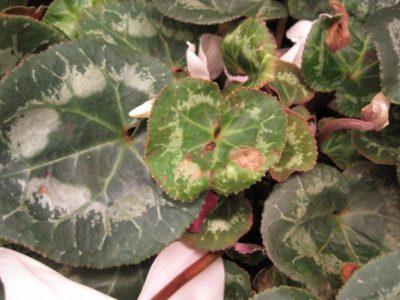

Cyclamen does not bypass the disease. The most common disease is gray mold... It manifests itself a month after the plant was affected. First, a soft gray bloom appears on the tubers, and only then on the leaves. The affected areas begin to rot. The cause of this disease is excessive watering, high humidity or lack of proper circulation. Leaves rot most quickly, and only then into the tubers.
You can also often encounter pests that precipitate cyclamen. These can be various mites, thrips and aphids. If such parasites are found, the plant should be treated with purchased chemicals. Such treatment will cause minor harm to the plant, but will save it from certain death and from parasites.
Using the medicinal properties of European cyclamen
Cyclamen European has been used in medicine for a long time. Its juice is excellent for rhinitis, sinusitis, colds, diseases of the female reproductive system, neuralgia, rheumatism, radiculitis, liver disease, intestinal colic.
Sinusitis treatment
Squeeze out the juice of one small cyclamen tuber, mix with boiled water (1:10) and instill this solution into the nose two to three times daily. It is imperative to dilute cyclamen juice, otherwise you can get a burn of the nasal mucosa.
Radiculitis treatment
Grind the cyclamen tuber, add vodka (1:10), let it brew for a week and strain. Rub the lower back.
Treatment of diseases of the gastrointestinal tract
Pour the crushed cyclamen tuber with hot boiled water (1 tablespoon of cyclamen per 500 ml of water), leave for about two hours, strain. Take a tablespoon three times a day after meals.
When self-treatment with cyclamen, remember that it is quite poisonous and the use of its juice inside requires prior consultation with a doctor.
Photo
The photo shows European and Persian cyclamen, you can see the differences between them.
European


Persian
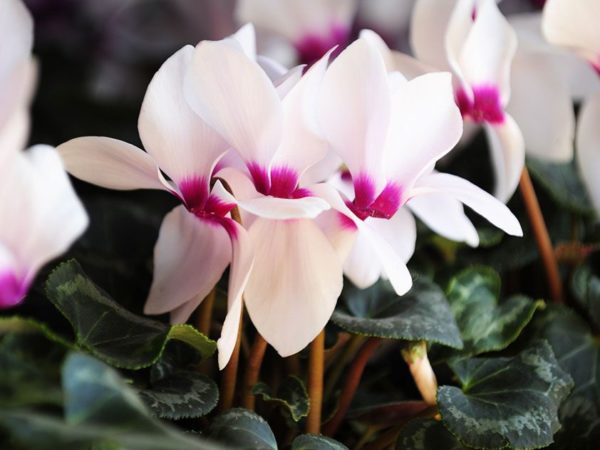

The magical properties of the European cyclamen
Even the ancient Romans believed that cyclamens protect against evil and unkind forces. It is believed that cyclamen is able to ward off bad dreams, relieve anxiety and groundless fears, self-doubt and creative stagnation, and protect against the evil eye and envy. To prevent the cyclamen from losing its magical power, it should be watered by adding water to the pan.
It is best to keep the cyclamen in the bedroom, not far from the bed, because it is in a dream that a person is more susceptible to the beneficial effects of this flower.If you believe the signs, cyclamen flowers help to forget unrequited or lost love, drowning out feelings of sadness and longing. Cyclamen flowers can also help with infertility.
Of course, cyclamen is a plant that requires careful care. But these delicate, touching flowers will adorn your apartment. A real alpine spring on the windowsill - isn't it wonderful?
| Flowering period | ||
| Location | During the winter months, plants are placed on western or eastern windowsills with good lighting. Or on shelves with additional lighting. | Shaded area in the garden or balcony. Better outdoors. Can be installed between window frames. |
| Temperature | The optimum temperature during this period is + 17 ... + 19 ° С. An increase to +25 ° C will perceive the flower as a signal to hibernation. | During this period, the plant does not react strongly to elevated temperatures. The coolness of the night on a loggia or balcony has a beneficial effect on the laying of the kidneys. |
| Watering | He does not like dampness, so water abundantly, but not often, it is better through a sump - this way the water does not get on the leaves and tubers. | Only slightly moisten an earthen lump with cold water, preventing the tubers from drying out and cracking. |
| Top dressing | Only adult plants once every 2 weeks at the rate of 1 g / 1 l. Any mineral potassium-phosphorus mixture with a reduced amount of nitrogen is suitable. | Not produced. |
| The reasons | ||
| Leaves turn yellow during the growing season. | Dry air, high temperature, lack of watering. | Provide regular watering, spray the space above the flower with a spray bottle, remove to a bright, cool place. |
| Leaves and peduncles rot, brown spots appear. | Excessive watering, water ingress into the outlet and on the tuber. | Remove the affected plant parts, dry, sprinkle with charcoal. Replace the soil, ensure good soil ventilation. |
| Flowering stops, the tips of the leaves turn yellow. | Fungus infection. | Replace the substrate. Process the flower with Topsin-M. |
| White bloom, dark spots on the leaves. | Gray rot. | Transplant the cyclamen into another pot, treat with fugicide, limit watering. |
| Flowers and leaves are deformed, covered with white strokes. | Defeat by thrips. | The plant is isolated, disinfestation is carried out with Spintor, Fitoverm, etc. |
| The leaves turn yellow, become covered with a gray bloom, growth and flowering cease. | Infection with cyclamen or spider mites. | Treat with insectoacaricides: Danitol, Mavrik, Sumiton, etc. |
Possible diseases
The violet is susceptible to various diseases (powdery mildew, rust, spotting, black leg, gray rot) and pests (clover scoop, cucumber mosaic virus, nematodes, pratilench).
But in the wild, plants are usually more hardy and protected from damage.
While watching the video, you will learn about the reproduction of violets.
Mountain (high) violet is a relict species listed in the Red Books of the regions of Russia, Ukraine, Belarus, CIS countries. It is necessary to make every effort to preserve it by developing programs for domestication and limiting the anthropogenic impact of man on nature in the places where the plant grows.
Attention super FLY!
Garden flowers
Interesting to read:
- Blue dragon violet: tenderness and brightness in one bottle
- Violet Winter cherry: care basics, bloom tips
- Violet "Curly Sue": how to grow a plant on your windowsill
- Description and features of growing violets Blue fog
- How to plant a violet: basic tips and tricks for planting and care
- Violet Chic poppy: characteristics, features of care and maintenance
- Aconite herb: a panacea for disease or poisonous poison
- How figs bloom: unique features of the southern handsome
- Bukharnik is soft: what it looks like and why it is grown
How and when to transplant a flower
Violets should be transplanted no more than once every couple of years. In this case, it is worth paying attention to the tubers of the plant and the soil. The best time for this will be autumn.
Transplanting rules depend on the plant variety.For example, the Persian cyclamen is planted so that the tubers are half covered with soil, while the European variety requires the roots to be completely immersed.
Violet propagates exclusively by seeds. They are harvested one and a half months after flowering. As soon as the flower has wilted, it is worth waiting for it to dry completely. Some growers still propagate the plant by dividing the bush.
Of all the pests, the mite is the most dangerous for him. The presence of a pest can be recognized by the leaves. If they start to curl up and stop growing, then it's time to sound the alarm. The violet can also be attacked by a beetle that eats the leaves. Its larvae usually lie in the roots, and in order to rid the flower of it, it is necessary to completely change the soil. Sometimes a scale insect may appear, which also belongs to the cyclamen pests.
Content
- 1. Description 1.1. Popular varieties and varieties
Cyclamen belongs to the Myrsinaceae family. The genus unites 50 species of tuberous herbaceous perennials. Among them are evergreen and deciduous.
The genus was named for the shape of the tubers: from the Greek kyklas, "round". The original Russian name, Dryakva, is associated with the effect of the poisonous Cyclamen on the body of animals eating parts of the plant. For those, there is "groaning", that is, trembling. Pigs are an exception, because Cyclamen's tubers were nicknamed "pork bread".
The Eastern Mediterranean is considered the birthplace of Cyclamen. The natural habitat is the mountainous coasts of the Caspian, Black and Mediterranean seas. In Europe, Cyclamen was first domesticated in 1656. Since then, it has been cultivated as a garden and indoor flowering and decorative leafy plant.
Description of the flower and its features
The very first flower was Persian cyclamen. His homeland was Turkey, as well as the Middle East. Almost all types of it require the same self-care.
The height of the flower ranges from fifteen to thirty centimeters. It is compact enough and grows well at home. Its delicate flowers usually bloom in the winter season and come in a variety of shades, from white to purple. The shape of the leaves is like a heart covered with a marble-like pattern as shown in the photo.
Cyclamen purpurascens, europaeus - Cyclamen purple, European


Family Myrsinaceae - Myrsinaceae.
Genus Cyclamen - Cyclamen.
Species: Cyclamen purpurascens - Cyclamen purple.
Sow bread, Florist's Cyclamen, European Cyclamen, Purple Cyclamen, Alpine violet, Dryakva.
Cyclamen purple, European - description, care, popular varieties.
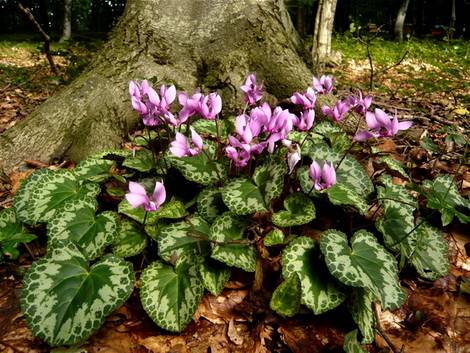

The European cyclamen is popularly called "alpine violet".
Cyclamen purpurascens, Cyclamen europaeus - Cyclamen purple, European or blushing... Synonyms: Cyclamen europaeum, Cyclamen fatrense. Naturally grows in Central Europe, northern Italy and Slovenia. It is a perennial plant with varied leaves and dark pink flowers in summer. By the nature of its distribution, it stands out from the general row of cyclamens, inhabiting alpine meadows with limestone soil and forests of Europe, at an altitude of 250-1300 m, in shaded and semi-shaded places among rocks and tree roots. The Latin name means “turn purple”. In nature, most of these plants live on calcareous soils, in mountainous areas, so they are popularly called alpine violets.
Previously, it was customary to consider the names of the type of cyclamen "purple" and "European" synonyms, from the old manuals it was sold on the Internet. Since 1972, Cyclamen purpurascens has been considered a more accurate name for the species, rather than European. Several other European species are found on sale under the name “European cyclamen”: notched cyclamen (C. repandum) and ivy-leaved cyclamen (C. hederifolium).
An evergreen herbaceous tuberous plant with a height of 10-15 cm. Tubers about 6-10 cm in diameter, spherical, elongated with thickenings, or irregularly shaped - elongated, flattened, with roots located over the entire surface, and underground stolons ending in daughter tubers.In adulthood, they are pale brown, smooth, then become rough, with up to 2 mm thick branched roots that appear from almost anywhere on the surface.
Above, the tubers bear shortened shoots with leaves close to the rosette. They have a powerful root system, which grows very densely in a pot. He has a tuber and daughter “baby fingers”, which can later be separated from the mother tuber for reproduction.
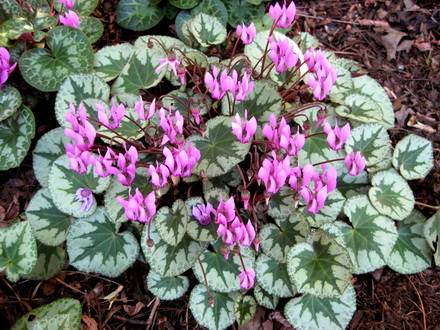

Flowers and leaves grow from buds on the upper surface of the rounded tuber. Roots grow from the sides and bottom. Old tubers can lose their shape, releasing “fingers” with separate growth points. When planting, the tuber of European cyclamen is completely covered with earth. Cyclamen has more than one European growth points, they are all over the tuber.
Leaves reniform to cordate, as wide as length or slightly more, leathery, about 2-4 cm in diameter. The edge of the leaf is smooth or slightly serrated. The color of the leaves ranges from completely green to completely silvery, although the more common coloration is green with a light green or silvery "pearl" that follows the contours of the leaf edge. The underside is reddish-purple. Cyclamen is a European evergreen plant, it does not shed foliage and does not have a pronounced dormant period, unlike Persian cyclamen.
Flowers with a sweet scent appear before or at the same time as leaves. Flowers 15-25 mm long, 5-10 mm wide, are colored from pale pink to purple or pink-carmine. The petals are elliptical, twisted, often curved like auricles. It blooms from summer to autumn, keeping its leaves all winter long. New leaves appear in the summer at the same time as the old ones fall off. The flowering intensity depends on the size of your plant and the quality of its care. After fertilization, the peduncle is twisted into a spiral, starting from the end. Amber-colored seeds are stored in a spherical pod, which ripens by the next summer after flowering and breaks down into 5-10 valves. The flowering time is regulated by the time of sowing seeds, watering, lighting and temperature.
Withered flowers or yellowed leaves should not be torn off, since the cyclamen tuber has only one growth point, and its damage if carelessly cutting off withered leaves and flowers can lead to the death of the plant - they must be removed by careful "twisting". "
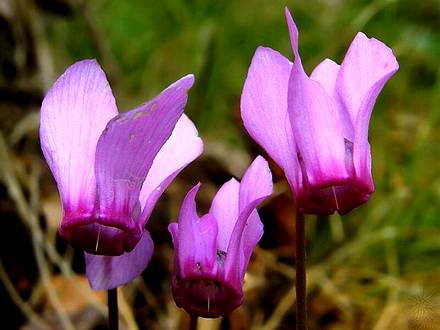

It has numerous forms with different colors of flowers, from white to carmine.
Cyclamen purpurascens has three wild-growing forms that differ in flower color:
Cyclamen purpurascens f. purpurascens - flowers from pink to purple;
Cyclamen purpurascens f. carmineolineatum - white flowers with a thin carmine rim;
Cyclamen purpurascens f. album - completely white flowers.
Cyclamen “Lake Garda” - silvery leaves and pink flowers;
Cyclamen “Lake Bled” - a silvery leaf with a reticulated pattern of veins near the edge;
Cyclamen “Limone” - silvery with a thin green edge and a gray lancet pattern in the center;
Cyclamen “Green Ice” - has a leaf with a silvery herringbone-shaped central part and a wide green edge;
Cyclamen “Green Lake” - similar to Green Ice, but on the contrary, the “herringbone” is light green, and the periphery is silvery;
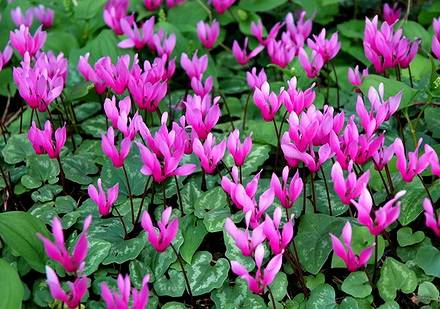

The acquisition of this type of cyclamen usually falls on the warm season. You should stop your choice on a plant that has just begun flowering. Its leaves should be dense, without yellowness and soft brown spots, without gray mold. When buying plants, first of all pay attention to the tuber. The tuber is usually completely submerged in the ground, only the very top can protrude. Cyclamen is an unpretentious plant that grows for an average of 15 years and blooms every year.
The advantages of purple cyclamen include its year-round decorativeness due to beautiful leaves with silvery stains, as well as the fact that its flowering only improves with age. Throughout the year, he feels great on the windowsills in the apartment, subject to the temperature of 18-20 ° C. In winter, cooler conditions are needed, up to 15 ° C. Not tied to a specific humidity level.
The location is bright and protected from direct sunlight.A shade or partial shade is better for him, northern windows with diffused constant light are optimal, in summer you can take out to a shaded balcony. Watering is regular in summer, the soil should not dry out too much, but excessive watering leads to rotting of the tuber. It is better to water from above, gently, along the edge of the pot, trying not to get on the leaves and tuber. Excess water from the sump should be drained shortly after watering. Water for irrigation should be at the temperature of the room where the plant stands, or 2-4 degrees warmer.
Cyclamen is fed purple from spring to autumn with half doses of fertilizer with a low nitrogen content (universal fertilizer is suitable). Top dressing begins no earlier than a month after the acquisition of the plant. During the rest period, they are completely stopped. Cyclamen is transplanted not often, every 2-4 years. It is better to do this before the start of a new wave of growth (in spring), carefully transferring it into a slightly larger pot. The tuber is completely covered with soil, but not deeply buried.


Propagated cyclamen purple seeds or dividing the tuber. This species forms lateral tubers that can be used for propagation. This should be done during the rest period. Cyclamen European is propagated by the separation of lateral tubers, which are formed at the ends of specialized underground stolons in the thickness of the earthen coma. If you remove the tuber from the ground, you will see where the tuber can be divided. There, inside it is of an irregular shape, and it will be directly visible that some kind of "potato" can be separated. Usually it is divided into two parts, sometimes the largest into three parts. Only do not divide into very small pieces, they will then hurt for a long time. Sprinkle the cut with charcoal and plant immediately. European cyclamens, unlike other species of this plant, are planted in low pots, since its tuber grows in breadth. When grown from their own seeds, splitting can be expected in the offspring; young cyclamens may differ from the original plants.
The dormant period in European cyclamen is not clearly marked and is expressed only in the fact that there is no flowering. During the dormant period, the plant ceases to bloom, but the foliage does not shed. But this does not mean at all that it should be left in the same place. Alpine violet also needs rest. In autumn, the cyclamen ends flowering and enters a rest period without shedding leaves (the leaves will be replaced next summer, simultaneously with flowering). It starts in October and lasts until spring. At this time, the pots should stand in a cool room, and very little watering is needed, allowing the earthy coma to dry out. Experienced flower growers often install pots with cyclamen on the windows between the frames, and in the summer on the balcony and with this content, the plants bloom from year to year from July to October very abundantly.


During the budding period, proper watering is very important. Excessive moisture causes their decay and the appearance of gray rot on the leaves. Drying out of the same earthen coma leads to the death of buds and the formation of short pedicels. Watered evenly: without overdrying and avoiding stagnation of water in the pot, always with soft, settled water and always from the pallet. Do not let water get into the middle of the leaf rosette. In summer, plants are watered more abundantly, but carefully, and on hot days, especially during flowering, they are shaded. Note that growing plants in open containers and baskets in your yard may require more frequent watering. Cyclamens can be grown like violets using the wick method. Flowering plants need to be fed every 2-3 weeks. With proper care, European cyclamen blooms even more abundantly than Persian.
European cyclamen can be grown in open ground (in a garden or in a country house, in a clearing protected from direct sun), but for the winter it must be covered with foliage and coniferous spruce branches.But nevertheless, in severe frosts, Cyclamen may not survive, therefore, in the fall, after the plant has faded, it is recommended to dig up the tubers and transplant them into long, low boxes with good drainage holes. Plants prepared for wintering can be left on a poorly heated veranda until spring, and all care for Cyclamen during this period should be reduced to ensuring that the night temperature does not drop to the minus mark of the thermometer.


Differences between Persian Cyclamen and European Cyclamen.
To understand how to care for cyclamen at home, you need to know which species the plant belongs to. Flowering time, dormancy period and transplanting depth differ between Cyclamen purpurascens and Cyclamen persicum.
The first difference between the Persian cyclamen and the European one is its availability. It is always available in stores, at any time of the year and in a variety of versions. The same is the case with seeds, the seeds of the European are really a rarity. European seeds can be ordered online or received by mail from amateurs.
The difference between the Persian cyclamen and other species of cyclamen in the timing of flowering and in the tuber. Persian cyclamen blooms in the autumn-winter period, and the European flowering occurs in the spring-summer period. In European tubers of irregular shape, clumsy, similar to Jerusalem artichoke, roots grow from everywhere, children can form at the ends of the outgrowths. In youth, the European tuber is also rounded. In Persian it is always, at any age, a neat rounded bulb. In the Neapolitans, in general, the roots grow from above, so they are buried more than usual, in gardens by 10 cm. In the Cossians, the roots grow from the bottom of the tuber, the tuber itself is velvety, brown.
Cossa flowers bloom very early in spring, before the leaves grow back. Europeans generally never shed their leaves until the end; they bloom from June to September. Neapolitans bloom in autumn, also before the leaves appear.
European and Neapolitan require good, rich soil, not acidic (add leaf humus and ash or dolomite), the Cossians need poorer soil.
During the period when forest cyclamens are not blooming, they are watered as usual. Except for the European, everyone tolerates both light and partial shade. The European needs shade or partial shade (best of all, northern windows with diffused constant light).
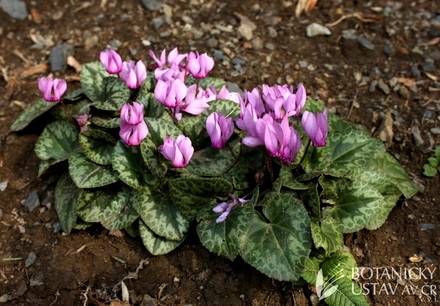

Most often in autumn and winter, Persian cyclamens are sold in bloom, in spring and summer - purple (European). The leaves are smaller than those of Persian cyclamen, round-heart-shaped, leathery, dark green with a silvery pattern, dark red underneath, about 2-4 cm in diameter. The flowers are also smaller, about 2 cm long, usually pink in color with a pleasant aroma. Persian cyclamens are larger and odorless, but some mini Persian varieties also smell very good. The European cyclamen is smaller and more delicate than its eastern relative.
You can find the statement that the flowers of Persian cyclamen are larger, however, with an abundance of modern hybrid varieties, it is difficult to distinguish between these two species by size, color or flower shape. There is also an opinion that only purple cyclamen flowers smell, which is also wrong.
Cyclamen European differs from Persian also in small leaves, which have a purple hue on the back. The Persian cyclamen has large leaves, 10-15 cm in diameter, heart-shaped. European cyclamen leaves are small, 2-4 cm in diameter, rounded. The most striking distinguishing feature is the color of the underside of the leaf. Look at the seamy side of the leaf, in the European it is purple, anthocyanin, even purple, in the Persian it is green, maybe with drawings.
Notice how the plant sits in the pot. If the tuber protrudes above the ground level, it is Persian cyclamen. If it is completely submerged in the soil, it is a European cyclamen. The Persian cyclamen tuber is spherical-flattened, does not form daughter tubers, the roots are formed only in the lower part.The tuber of European cyclamen grows over time, forms small daughter nodules. The roots are located over the entire surface of the tuber. Europeans have more than one growth point, they are all over the tuber.
Continuation: Cyclamen - a description of the flower, how to water, temperature, plant care.
Continuation: Cyclamen - planting and transplanting, reproduction, diseases and problems in care.
Continuation: Popular types and varieties of Cyclamen.
Continuation: Persian cyclamen - description, care, popular varieties.


Features of seasonal care
It is useful to clarify information about agricultural activities at different times of the year:
- In the spring, the houseplant has bloomed and is preparing for rest. At this time, watering is reduced to a minimum, fertilization is stopped.
- In summer, the flowerpot is placed in a dark, cool place, the tuber is not watered.
- At the end of August, the pot is placed in a lighted place, a transplant is performed, and they gradually begin to water along the edge of the flowerpot. The first feeding is done after 1 month with phosphorus-potassium fertilizers, the next - once every couple of weeks.
- From September to November, foliage is actively formed, which can be sprayed with settled water. Peduncles sprout from the end of autumn. During this period, fertilizers are stopped and cyclamen is sprayed.
Cyclamen in the house: signs and superstitions
Many people grow alpine violets at home and do not know about its effect on humans. There are several signs that characterize the influence of cyclamen on households and home.
Popular opinions about the plant:
- Helps with depression, fears, problems in the love sphere.
- Strengthens family relationships among family members.
- Protects against bad energy.
- Relieves insomnia.
- Cleans the human biofield.
- Accelerates the receipt of material benefits against the background of professional growth and a successful career.
Before buying a cyclamen, it is useful to read the rules for growing Alpine violets, to choose a variety that is easier to care for. When the recommendations are followed, delicate pink buds are pleasing to the eye, despite the frost and blizzard outside the window.
Below is a video, after watching which you can learn more secrets of growing cyclamen, which will help keep the plant in bloom all year round:
Temperature and light conditions
Cyclamen prefers
cool rooms. Ideal
temperature
for the cultivation of European cyclamen is + 12 + 17 ° С. In the summer, it will be quite difficult to maintain such a temperature regime, therefore, it is necessary to try to organize such conditions under which the temperature will not rise at least above + 25 ° С. If the room gets hotter, the flower may wither.
Winter pot
with an alpine violet flower should be kept away from heating radiators, but provide it with a lot of light. Drafts can have a bad effect on the condition of the plant, as well as the direct rays of the sun falling on its leaves. The room where the plant is located must be regularly ventilated.
Hibernation
According to my observations, the European cyclamen hibernates only because of the very modest light regime of our latitudes - in winter it is too dark for normal growth and vegetation. Nevertheless, growth in autumn and winter slows down, but does not stop - with an obvious lack of light, winter leaves with long petioles appear. In winter, I keep the pots with cyclamen closer to the light, do not shade the rare Moscow sun, but water it almost the same way as in summer, especially since the air in the apartment is still dry. By February, the plant is already starting to wake up, so do not delay the transplant.
Diseases
| Disease | Causes / Symptoms | Treatment |
| Wet rot | The disease is bacterial and manifests itself in the form of wilting leaves and peduncles hanging from the pot. The flower grower feels a putrid smell. This disease appears in conditions of warmth and humidity. | Can't be cured the plant is destroyed |
| Gray rot | Appears in damp and cold conditions. The spores of the Botrytis fungus are spread by wind and water. The plant becomes ill if the conditions of detention are violated. Gray mold appears on the leaves and buds. Leaves and peduncles turn yellow and die | Treat the plant by removing damaged parts of the plant and using fungicides |
| Anthracnose | This disease develops in a warm and humid atmosphere. The fungus affects peduncles and leaves that develop poorly and are deformed | Damaged plant parts are removed and treat cyclamen with fungicides |
| Sooty fungus | The appearance of the fungus indicates that parasites attacked the cyclamen. A sticky discharge with a black fungus appears on the leaves. In the end leaves dry and fall | Fungal plaque is treated with green soap, you can apply Bordeaux liquid |


The defeat of the fungus may indicate an attack of parasites on the plant.
Cyclamen has a beneficial effect on emotional people. It fills the room with positive energy, which contributes to maintaining a favorable atmosphere in the house.
People have a desire to do good to others. Cyclamen looks beautiful and is worth the space on the windowsill. It will bring peace and tranquility to the house.
Care
Alpine violet is as beautiful as it is capricious. And in order to admire the flowering of the alpine princess, it is very important to take into account all the nuances of care
Temperature regime and illumination
Alpine violet prefers rather cool weather. The flower will feel most comfortable at a temperature of 10-19 degrees. If the temperature rises to +25 degrees, then the cyclamen will regard this as a message that the hot summer time has come, and therefore it is time to rest.
How important it is all the same not to be mistaken with the choice of residence for a capricious alpine violet!
Until the temperature drops below +8 degrees, the flower will feel great in the shade on the loggia or on the garden terrace. It is the cool night temperatures that will promote the formation of flower buds.
And for a blooming cyclamen, you should definitely find the most illuminated and coolest place in the house. Like other plants that bloom in winter, cyclamen requires stable lighting.
It is imperative to arrange additional lighting for the plant on short winter days.
The ideal would be to find a balance between light and temperature. Indeed, at a fairly cool temperature, but in a gloomy room, the flowers of the alpine violet will become thinner. And if the brightness of the lighting fixtures is too high, the colors will fade quickly.
Moisturizing and watering
Watering for a blooming delicate beauty should be regular, otherwise the leaves and flowers begin to fade quickly. When the flowering is over, the plant should be watered less often and less often, and by the rest period, the soil should only be slightly moistened in order to protect the plant from drying out.
This flower can be watered by pouring water into the pan. Delicate leaves do not like getting water on them. And if water gets to the growing point, then this can destroy the delicate flower.
Alpine violet does not tolerate waterlogging of the soil, which leads to the occurrence of fungal diseases. Therefore, watering should be plentiful enough to soak the entire earthen lump, but you must definitely give it time to dry.
When caring for an alpine violet, it is imperative to monitor the humidity of the air. Since the leaves do not like moisture ingress, you can use a fine spray to spray the air around the plant.
Very good moisture will be served by the neighborhood with large deciduous specimens, which are capable of evaporating a large amount of moisture. You can put an aquarium next to it or just a jar of water.
Top dressing
- Alpine violets need top dressing only during the growing season - from October to March.
- The frequency of feeding is once every two weeks.
- During rest, no fertilizing is performed.
- Fertilizers are versatile mixtures containing a lot of potassium and phosphorus. Nitrogen, which promotes foliage growth, can damage flowering. The types of dressings can be alternated.
Transplant and reproduction
In autumn, with the beginning of the growing season, the tuber begins to overgrow with leaves. This is the best period for a transplant.
- The pot is chosen 3-4 centimeters more than the volume of the roots. A large pot will inhibit abundant flowering.
- Soil composition: peat, garden soil, sand and humus, in equal parts. The soil is needed loose and moisture-permeable.
When planting a Persian cyclamen, the bulb is left a third above the ground. All other species must be planted by completely immersing the bulb in the ground, but not very deeply.
In early spring, you can propagate the flower with seeds, and at the end of summer with daughter tubers.
Seeds must be soaked in Epin before planting. Sowing is carried out in a moistened peat-sand mixture, 2-3 cm apart, covered with glass and germinated at 20 degrees in a shaded place.
After a month, the seedlings are determined to grow in bright, but diffused light. With the appearance of a pair of leaves, they dive into the pots
- alpine violet or cyclamen
- types of cyclamen
- alpine violet: home care
- alpine violet: garden care
- medicinal properties of cyclamen
- alpine violet: photo
- alpine violet buy
Air humidity and watering
Spray
This plant is not needed, but if the room temperature is too high, you can lightly spray the air itself around the flower.
Such a measure helps well in cases where the temperature in the room is higher than the recommended one, and the flower will thus be able to withstand the heat.
In caring for an alpine violet watering
should be done very carefully. It is impossible for the water to fall on the flowers, shoots and tubers of the plant - this can lead to its death.
During flowering
watering should be done often, but make sure that the soil is not waterlogged.
During the rest period
you need to water much less often, only when the soil is already dry enough. Experienced growers recommend pouring water directly into the tray.
For watering use
soft water, preferably settled for about a day, or filtered.
How to care?
At home, caring for a flower is not very difficult, but requires compliance with some rules
.
- First of all, you need to find a suitable place for the alpine violet. The plant, although unpretentious, loves diffused light and well-ventilated rooms. Drafts are contraindicated in the flower.
- Temperature conditions are very important. It belongs to cold-loving plants, therefore it does not tolerate high temperatures. An alpine violet feels comfortable at temperatures ranging from + 14C to + 16C.
- If in the summer it is not possible to maintain the temperature that is optimal for growth, then the plant can be transferred to the basement. However, there must be sufficient lighting in the room. If this is not possible, then the flower can be left in a room where the air temperature should not exceed + 25C.
- In winter, when heaters and central heating radiators are turned on in the room, it is recommended to place the cyclamens away from heat sources. In this case, you need to monitor the level of humidity in the room, and water the plant in a timely manner.
- Too low room temperatures and excessive watering can lead to rotting, and then to the death of the flower.
How to water properly?
Alpine violet is moisture-loving plant
, which at home must be watered in a timely manner, abundantly and regularly.
At any time during the life of a flower, watering requires accuracy. It is recommended to water cyclamen through a sump, since water ingress on the stems, peduncles or tuber provokes rotting. Cuttings or flowers first begin to be covered with brown spots, and then the plant dies.
Water for watering the plant should be at room temperature and be separated. Watering plants with tap water is not recommended. If the flower requires watering, and there was no settled water in the house, then you can pour it with boiled water, previously cooled to room temperature.
When caring for an alpine violet, it is necessary to ensure that the water in the pan and pot does not stagnate for a long time. After the flower is watered, and all layers of soil are saturated with moisture, from the pallet need to pour out excess water
.
The Persian tuber rises above the soil, so the plant can be watered in the usual way.
Top dressing
Twice a month, during the period of active growth of leaves and during flowering, the alpine violet should be fed.
It is recommended to feed at home during watering with special fertilizers for flowering plants. At the same time, nitrogen fertilizers should not be abused, an excess of which will negatively affect the quantity and quality of flowers, and lead to a strong foliage build-up.
Resting care
After the plant has faded, its leaves begin to turn yellow and fall off
... This is the first sign that the flower is entering a dormant period. At this time, at home, the alpine violet requires special care.
After flowering, the life of the alpine violet is supported by its tuber.
Transfer
Caring for a plant at home includes a flower transplant, which is usually done during the summer. In this case, it is necessary follow some rules:
- after transplanting, the upper third of the plant's tuber should remain above the ground;
- the transplant is carried out in a pot, which should be 2-2.5 cm larger than the previous one;
- the soil can be prepared independently by taking for this leafy soil, river sand, humus and peat in proportions of 3: 1: 1: 1;
- before planting on the bottom of the pot, you first need to pour a layer of expanded clay, then add the prepared soil, on which to place the plant and sprinkle it on the sides with an earthen mixture;
- watering the plant can be started only 10-12 days after transplanting;
- in early September, when young leaves begin to form, the flower must be rearranged in a cool but sunny place.
Classic problems
Yellowing of leaves
After flowering, foliage and root systems will deteriorate. If the rhizome looks good on the outside, the plant may be too hot. Yellow spots appear when exposed to direct sunlight, dry air, or over-watering.
Short flowering period
Usually caused by a combination of dry and warm air or a lack of water. Provided that the plant bloomed profusely at the time of purchase.
The leaves are lethargic and drooping
The plant dies due to over-watering. You need to immediately change the soil.
Breeding features
Alpine violet reproduces by separating daughter tubers and seeds... The first option is simple to execute and makes it possible to quickly get a young flowering plant. It is enough to cut off the formed tuber and plant it in a separate pot.
Loose neutral soil must be used. A universal mixture for flowering plants, to which coarse sand is added, is suitable. The daughter tuber is completely buried in the ground.
Seed propagation takes a long time... At home, it will require artificial pollination of flowers. Before planting, it is recommended to soak the seed in a zircon solution for 20-24 hours. The seeds are sown in a mixture of peat and vermiculite (1: 1), sprinkled with sand on top.
Cover with a dark film until shoots appear. Germination takes about 1 month, periodically the soil is moistened. The resulting seedlings will bloom in 8-14 months.
Watch a video about the propagation of European cyclamen with tubers and seeds:
Care errors and their elimination
Useful information about negative phenomena on indoor flowers is collected in the table:
| Problems | The reasons | Elimination |
| Brown spots on tubers and leaves | The consequence of waterlogged soil and cool indoor air | Reduce the amount of watering, normalize the temperature in the room. |
| Yellow foliage | Low humidity in the house, insufficient soil moisture | Increase the regularity of watering, do not allow dry air. |
| Yellowed foliage and cuttings | Using hard water | The liquid must settle |
| Falling leaves | Lack of nutrition and moisture in the soil | The number of watering is increased, fertilizing is carried out with mineral or organic fertilizers. |
| The buds are hiding under the foliage | Low home temperature, insufficient lighting, humid air | The temperature regime is brought back to normal, the amount of light is increased, the humidity is normalized |
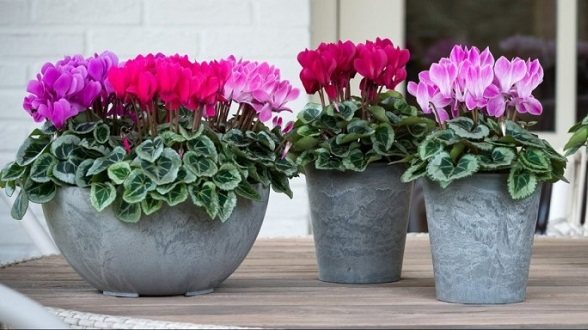

Views
Alpine violet began to be grown in Europe as an ornamental plant in the 19th century, with the advent of spectacularly flowering species. Later, the hobby began for other, more modest varieties.
Of the entire genus of cyclamen in domestic culture, purple and Persian are known.
Cyclamen Persian
The roots of this herbaceous plant are in the form of tubers, up to 15 centimeters in diameter, from which the roots themselves grow from below. The leaves are heart-shaped, their diameter reaches 14 centimeters.
The leaf plate has a green color below, and is covered with a silvery pattern on top. The petals on the flowers have an oblong-lanceolate shape up to 5 centimeters long.
The species is pink, white or lavender with darker spots at the base.
This cyclamen begins a dormant period in early summer. The leaves turn yellow and fall off, leaving only the tuber.
Cyclamen european
Refers to evergreen tuberous herbaceous plants. The roots are located on the tuber from all sides. The ball-shaped tuber itself has a diameter of about 10 centimeters.
Heart-shaped leaf plates, dark green in color, with a silvery ornament on top. The underside of the leaf is dark red.
The flowers are small, up to two centimeters long, pale pink, with a pleasant aroma.
This species begins to bloom in the spring and blooms all summer. This type of alpine violet does not have a pronounced dormant period. In addition to such popular ones, there are more rare types of cyclamens.
Cyclamen intarium
This flower is of Turkish origin, it is the smallest of all varieties, its flowers are small, white in color.
Cyclamen ivy
The habitat of this species is the European territory. In the hot summer, the flower becomes bald. With the arrival of autumn, lovely flowers first appear on it, and only then the leaves appear.
Cyclamen ivy belongs to long-livers, it can live up to 130 years, and the tuber grows up to 25 centimeters in diameter.
Cyclamen Lebanese
As the name implies, Lebanon is its homeland. This species has the longest flowering period. It blooms with delicate pink flowers with thin red veins. The flowers are quite large for the species, up to 3 centimeters in length.
Success secrets
Indoor Cyclamens:
Cyclamen needs regular ventilation of the room, but cannot stand drafts.
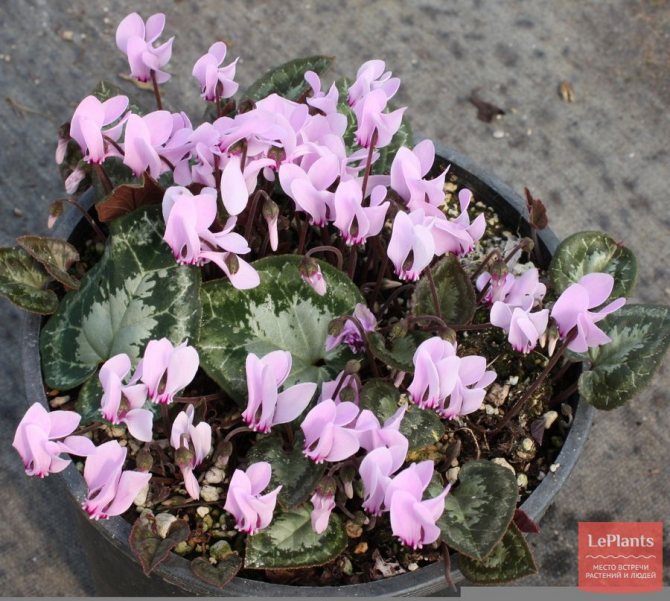

ON THE PICTURE: Outdoor hardening strengthens the health of indoor Cyclamen.
The plant is transplanted every two years, in summer or autumn, after germination of young heart-shaped leaves from the tubers. When transplanting, it is imperative to remove the decayed parts of the rhizome without damaging the healthy roots.
One third of the tuber is left above the soil surface. With a sharp temperature drop, cracking of the tuberous top is possible, therefore the thermal regime of the content changes gradually.
Cyclamen's tuber, which is often discarded, can germinate after flowering. To do this, it is placed on the east or west window, in a shaded place, and watered once a month throughout the summer.
For the prevention of fungal diseases, crushed pine bark is added to the substrate for Cyclamens, in an amount of 5% of the volume of the soil mixture.
In order for the future flowering to be abundant, the plant is planted in a cramped pot. It is important to remove dry leaves and flowers for even flowering. Buds ahead of mass flowering are also removed.
Outdoor plants:
Due to their mountainous origin, Cyclamens grow well on alpine hills and other rocky flower beds. Drakes look harmoniously in mixborders.
In middle latitudes and to the north, garden plants are covered with spruce branches or fallen leaves for the winter.
The soil around the Cyclamen plantings is periodically loosened. The leaves of dense bushes move apart for light access: this increases the decorative effect of the buds.
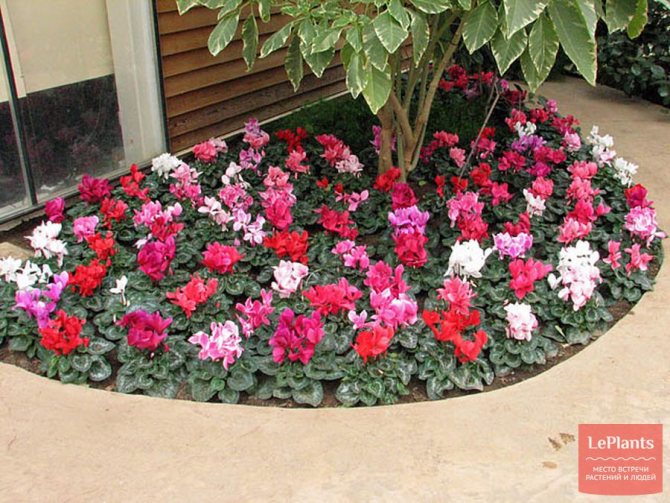

ON THE PICTURE: To protect outdoor Cyclamens from drafts and direct sunlight, you can plant them near deciduous trees and shrubs.
To preserve the beauty of Cyclamens brought from a flower bed for a long time, the advice in the article: "Learning to prolong the life of cut flowers" will help.
Reproduction
Seed method:
Cyclamen seeds are stored for six years, reaching the most uniform germination in the second year of storage. The sowing time of Cyclamen depends on the variety and variety. It is also influenced by the length of daylight hours.
In Siberia, the Leningrad region and the Urals, Cyclamen is sown in July-September. In the south, in the Crimea and Krasnodar Territory, sowing is carried out from November to February. In the middle lane, you can sow from late summer to mid-winter.
Before sowing, seeds, especially those stored for a long time, are left for a day in water with a temperature of + 20 ° C or treated with the Epin-Extra growth stimulator. After drying, it is sown into a 1: 1 sand and peat substrate, embedded in grooves 1 cm deep at a distance of 2-3 cm. After embedding, the soil is lightly sprayed from a sprayer.
Then the sowing is covered with black film or thick paper for quick seed germination. In order to preserve moisture, the soil is sometimes mulched with a layer of peat 2–3 cm. It should be poured onto a sand “pillow” in order to quickly remove it when shoots appear.
To germinate seeds, you need a temperature of + 18 °20 ° C and a sufficient amount of light. Sprouts appear in 20-30 days. The coating is removed, the substrate is loosened. Seedlings are moistened by spraying, placed in a lighted place without exposure to direct sunlight. The temperature of the content is gradually reduced to + 15 - 18 ° C.
Usually produced two picks seedlings of Cyclamen:
- With the development of the first true leaf.
- At the stage of four to five leaves, when they close.
The young plants remaining after the picks are planted in containers of suitable size without compaction of the soil.
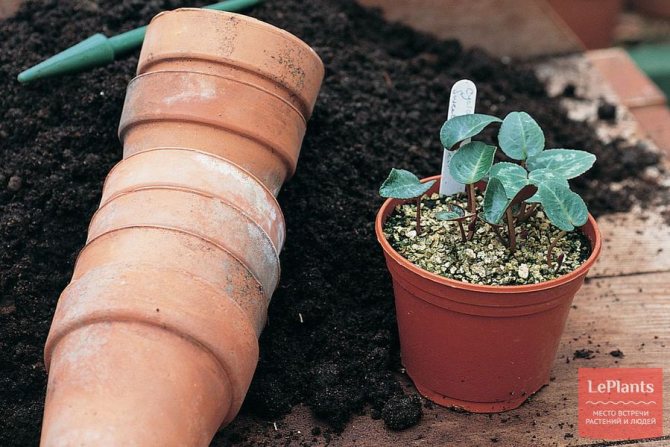

ON THE PICTURE: When planting Cyclamen seedlings in new pots, it is better to choose containers made from natural materials, for example, clay. It is important for the root system of young plants to "breathe" fully.
Dividing tubers:
Cyclamen tubers intended for propagation are removed after all the leaves have died. For this purpose, only corms of mature plants are suitable.
Having carefully freed the tubers from the soil, they are cut so that a growing point remains on each part, the so-called. "Peephole". The incision is made in the center, from bottom to top. After separation, the sections are treated with a fungicide and dusted with charcoal.


ON THE PICTURE: The tuber cut is an "Achilles heel" through which pathogens of various infections can penetrate. Therefore, the treatment of planting material with a fungicide is required.
Parts of the tubers are dried and planted in a mixture of sand, loam and leafy soil 1: 1: 2. Plantings are regularly watered and supplemented with light before germination. The emerging seedlings are looked after in the same way as the seedlings.
Typical diseases
Bacterial soft rot and fusarium
The yellowed plant withers and dies quickly. The corms become moist and soft.To prevent cyclamen disease, corms must be purchased from reputable sources and planted in a clean environment. When reusing the pot, clean it thoroughly with a household disinfectant or mild bleach solution before planting.
Botrytis
Dark spots appear on the leaves. The flower petals appear watery at first, and then a gray fungus appears. You can save the cyclamen at an early stage. It is necessary to improve air circulation - regularly ventilate the room. The disease is contagious, so you should carefully monitor the plants that are located nearby and, if possible, isolate other flowerpots.
Tielaviopeis
Causes plant wilting. The roots turn black and shriveled. You can try to save the plant with chemicals. During treatment, the cyclamen must be placed in a separate room.
Viruses cause a variety of symptoms, including deformation of leaves and flowers, abnormal formations on buds, stripes and ring spots appear.


Disease of cyclamen with characteristic spots.
The infected alpine violet should be thrown away, otherwise all plants in the room may die.
Lighting conditions for cyclamen european
Our cyclamens are very light-requiring, but at the same time they do not like direct light. How to solve this problem? The obvious solution is a north or shaded window. My grandmother did just that. However, flowering under such conditions will begin only in June, and will end early too. I solve the problem in a different way. The best alpine cyclamen grew on my southern window, under one but very important condition. From early spring to late summer, the lower part of the window was covered with thick sheets of white landscape paper so that direct rays did not fall on the leaves. One sheet in thickness is enough, but 2-3 of them may be needed to cover all directions of the incident light rays. Under such conditions, flowering will be from April to December inclusive, with almost no hibernation.


